Globetrottin
BY GOWAY

MY FIRST AFRICAN SAFARI
BEHIND THE CAMERA WITH A NATURAL HISTORY CINEMATOGRAPHER
A BEGINNER’S GUIDE TO BIRDING & TRAVEL
ISSUE
THE WILDLIFE

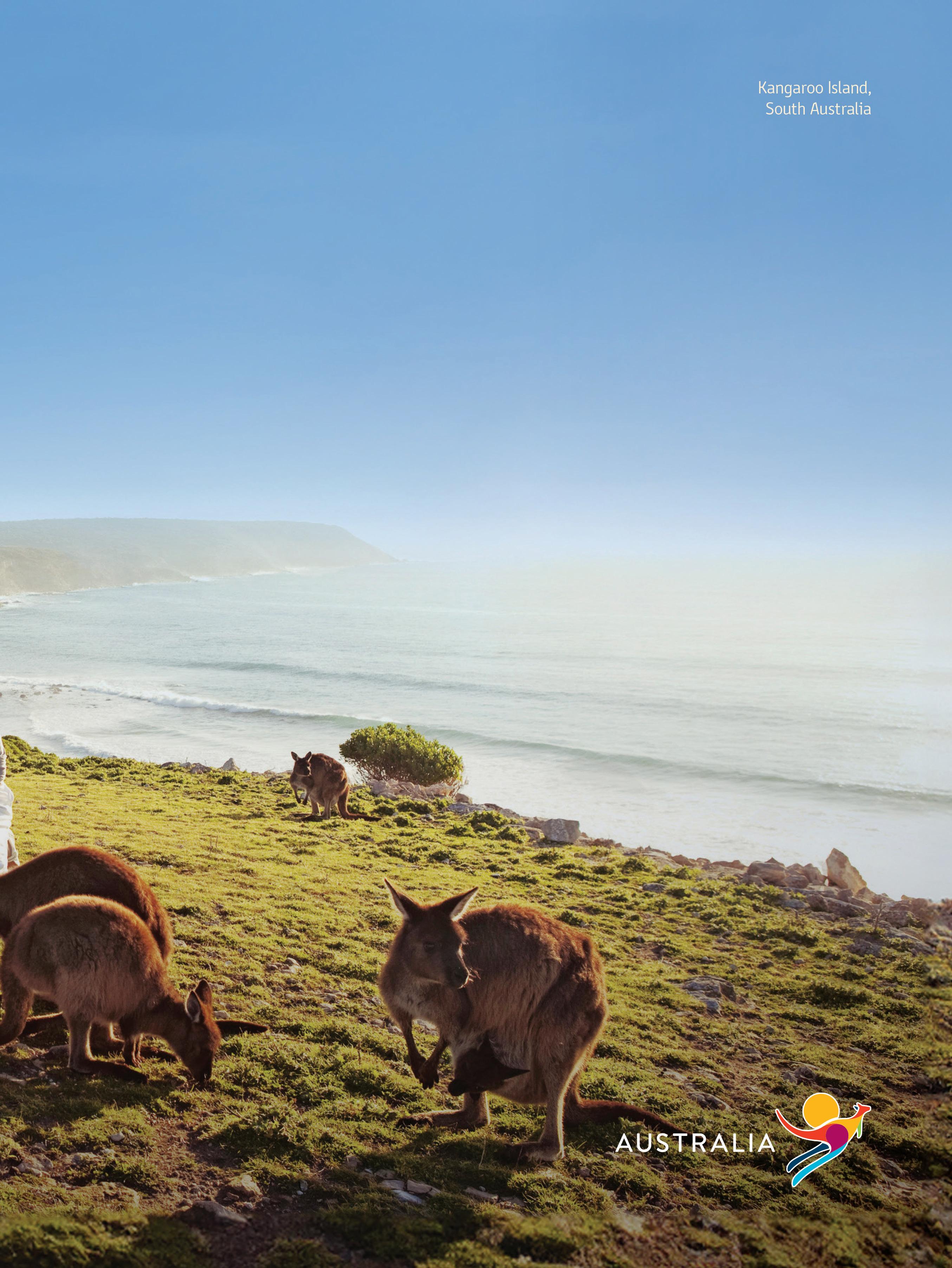

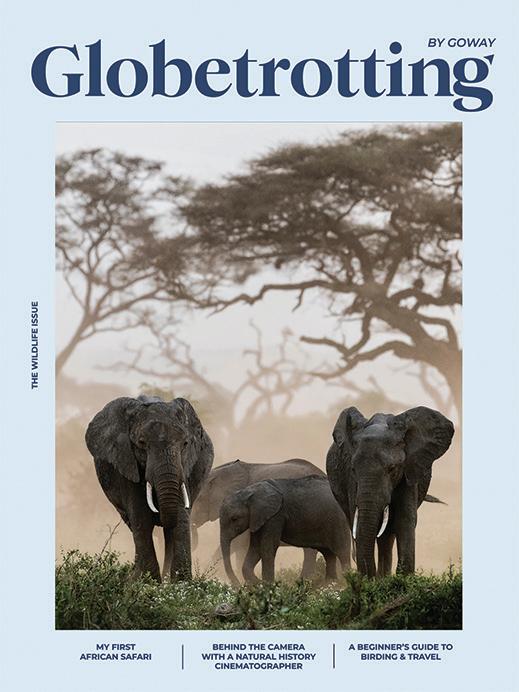
4
THE COVER Acacia leaves are an important food source for elephants and other large African herbivores. 22 A Beginner’s Guide to Birding and Travel Travel on the wing. 27 Wild Encounters Five unforgettable adventures in Tropical North Queensland. 28 Behind the Camera with a Natural History Cinematographer Insights from a career in the wild. 32 My First African Safari The thrill of seeing African animals will stay with you forever. 38 Kangaroo Island Bounces Back The biodiverse Australian paradise is recovering from the wildfires of 2019/20 . 40 Beauty of the Beast An ode to Scottish Highland Cattle. 42 See New Zealand Through a Steward’s Eyes Māori guidance unlocks the nation’s unforgettable landscape and wildlife. 44 Alaska: Where the Wild Things Are You don’t have to look far to see animals in Alaska. 46 Seasonal Whale Watching Calendar The best spots for whale watching throughout the year. 48 Into the Bush The long, careful work of mountain gorilla tracking. 51 Guardians of the Green The Bishnoi legacy of wildlife conservation and sustainability. 54 The Other Corcovado Costa Rica’s biodiverse haven. 58 Keeping it Green in the Wonderful Western Cape South Africa’s Western Cape is a haven for sustainable travel.
STORIES See life through the lens of a natural history cinematographer.
ON
28

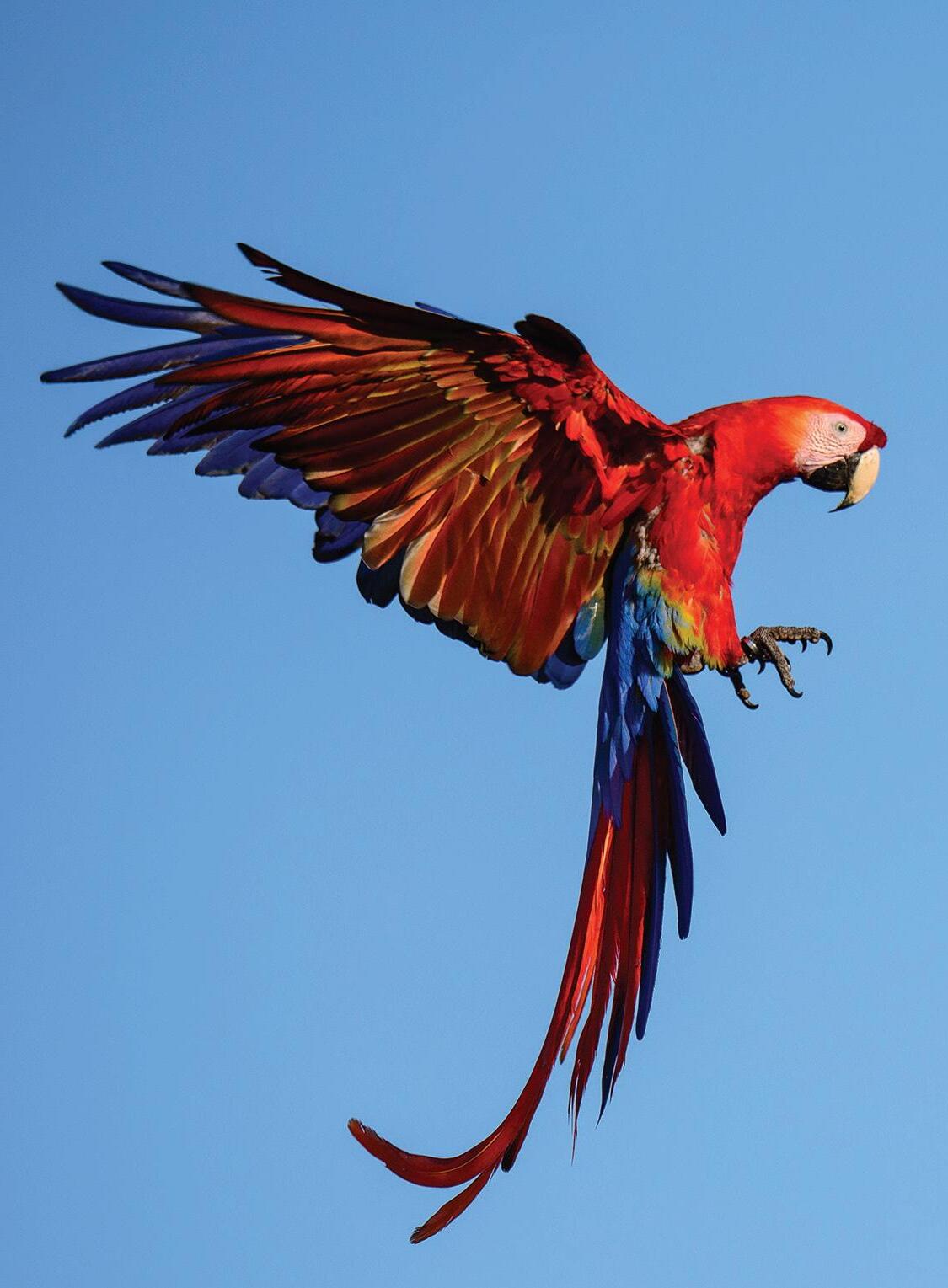
5 INSIDER’S GUIDE 9 Editor’s Letter 10 Trending: Rail Travel, New hotels, flights & tours 12 Visual Travel: Lions in the Bush 13 Ask an Expert: Responsible Safari Travel 14 Off the Beaten Path: Songo Songo Archipelago, Tanzania 15 The Nightcap: The Sazerac 16 The Splurge: Copacabana Palace, Rio de Janeiro 17 Recommended: Wildlife Memoirs 18 Tested: A6 Memobottle 19 1 Destination 2 Ways: Amsterdam, Cityscape or Countryside 20 Book Ahead: Melbourne in January 58 Group Travel Planning: A Group Safari in Kenya & Tanzania 58 Travel Like A Globetrotter: The Timeless Appeal of Going on Safari 60 The Archive: The Goway Bird 46 22 Like travel, a passion for birds leads to a broader curiosity for our natural world. You can find humpback whales in every one of the world’s oceans.
Globetrottin
EDITOR-IN-CHIEF : Mitchell Fawcett
MANAGING EDITOR : Aren Bergstrom
ART DIRECTOR : Gareth Adamson
GRAPHIC DESIGN : Negar Tavakol
CREATIVE PRODUCTION : Melissa Mirabelli
PARTNERSHIPS : Lori Petteplace
GOWAY CONTRIBUTORS : Nº33
Ch
ian Baines

Jennifer Murray

MoiraSmith
Kel Cleaveland Gi Dorey


DhruvRazdan


SaelForster

C Rusch MegSmith


La Vagners


C
yn Weppler

Globetrotting is published by Goway Travel
Web : www.goway.com
Email : info@goway.com
Social : @GowayTravel
Phone : 800-387-8850
Thank you to our travel partners for their support in this volume of Globetrotting :
APT Tours, Tourism Australia, Tourism New Zealand & Air New Zealand, Tourism Tropical North Queensland Limited, Wesgro – Provincial Tourism Authority for Cape Town and the Western Cape
6

MARCK GUTT
Marck Gutt is a travel writer and professional photographer from Vancouver, via Mexico City. His stories on sustainable tourism are often featured in publications including Esquire Latin America, Food and Travel Mexico, and National Geographic Latin America. Mountains are his happy place and croissants his first true love. Marck goes by he/him and firmly believes that no human is illegal.

Eric Hendrikx is a renowned author and writer whose globetrotting pursuits have taken him to far reaches around the world in search of fantastic foods and great places to ride motorcycles. On his journalistic adventures, he’s shared a grill with Jason Momoa, cruised on motorcycles with Keanu Reeves, and skateboarded with Tony Hawk. He currently lives in Toronto with his wife and their two black labs.

Toronto-based Danny Sinopoli is the former Style editor of The Globe and Mail and former editor-in-chief of Azure He currently writes about travel, food, architecture, and design for publications such as Condé Nast Traveler. In 2023 he launched the biweekly travel and lifestyle newsletter Worldly Goodness.

Jill K. Robinson writes about travel and adventure for National Geographic, AFAR, Condé Nast Traveler, Travel + Leisure, Outside, Sierra, Virtuoso The Magazine, Hemispheres, and more. She has won three Lowell Thomas Awards from the Society of American Travel Writers Foundation in the categories of Foreign Travel, Culinary-Related Travel, and Environmental and Sustainable Tourism.
7
ERIC HENDRIKX
DANNY SINOPOLI
GUEST CONTRIBUTORS
JILL ROBINSON


Dear Globetrotter
In 54 years of business, we can confidently say we have never encountered a traveler without an affection for the natural world. It’s simply a fundamental part of travel, and our first ever Wildlife Issue celebrates that.
As we worked on this issue, I noticed something: while we write about travel with passion, we write about animals with love. With such a universal theme, the pitch meetings were bountiful, and the pieces of this issue came together naturally. The ideas flowed freely, and pruning the list was easily our biggest challenge. Playing favourites in the animal kingdom is hard work.
We’re very proud of the stories that made the cut. We take you to Alaska’s coastal forests and rugged tundra (page 44) and introduce you to the colourfully tranquil world of birding (page 22). Our cover story highlights four Goway team members (myself included) on our very first safari experiences (page 32,) and the story on Scottland’s highland cattle from award winning writer Eric Hendrikx (page 40) truly reads like a love letter.
We consider it our responsibility to connect you with responsible and sustainable wildlife experiences, working diligently with partners who share our high standards and respect for animal
welfare. It’s every traveler’s responsibility to cherish and respect the natural world as they embark on their own journeys, and together, we can ensure that future generations of globetrotters can write their own stories like these.
I hope you enjoy our wildest issue ever.

9
EDITOR’S LETTER
Editor-in-Chief
TRENDING
Rail Travel
Rediscovering its timeless appeal.
Why is it trending?
A rail journey is more than a trip into the nostalgic past of travel; it’s a forward-thinking choice for today’s globetrotters. The style and luxury of contemporary trains have evolved beyond rail’s traditional past to a more sustainable, convenient, cost-effective, comfortable, and safer way to see the world.
Where can you explore by train?
No two countries have perfected rail travel quite like Switzerland and Japan. The Grand Train Tour of Switzerland whisks you through the country’s unique alpine scenery in outstanding panoramic trains. Japan’s world-renowned railway system will connect you from downtown Tokyo to enchanting Mount Fuji, Hiroshima, the Japanese Alps, and beyond.
Destinations including Canada, France, Germany, Malaysia, New Zealand, Peru, South Africa, South Korea, Spain, Türkiye, and Vietnam showcase some of the world’s most memorable rail journeys, from luxurious scenic routes to immersive cultural explorations and wildlife adventures.
What are some unique rail experiences?
Australia’s iconic journey from Darwin to Adelaide aboard The Ghan offers travellers a luxurious opportunity to uncover the Aussie Outback from private cabins with gourmet meals and off-train experiences.
The Rocky Mountaineer journey from Vancouver to Jasper is an enthralling three-day experience through the Canadian Rockies. Race through incredible ocean and mountain scenery to the stunning vistas in Whistler and the northern charm of Quesnel en route to the beautiful town of Jasper, nestled in the heart of Canada’s largest Rockies national park.
What are the world’s most luxurious rail journeys?
The Venice Simplon-Orient-Express is aptly considered one of the world’s most luxurious trains, comprised of 17 authentic and restored 1920s carriages of its sister train, the iconic Orient Express.
Rovos Rail offers one of the most unique safari experiences through the heart of Africa, from Cape Town to Tanzania. Watch Africa’s natural wonder unfold in front of your eyes aboard vintage wood-panelled coaches with fine dining options and suites on one of the world’s most luxurious trains.


10
Rail travel allows for incredible photo opportunities right outside the window.
The Landwasser Viaduct near Filisur is one of the iconic landmarks of the Swiss Alps.
New & Noteworthy
Get the scoop on interesting new places to stay and ways to explore the world.

A New Way to Explore Maya Temples in Belize
While neighbouring Guatemala typically comes to mind for its Mayan sites, travellers can also explore a fascinating sample of Mayan civilization on a new tour in northern Belize. Ride a boat up the river from Orange Walk Town, passing tropical birds and iguanas, to reach Lamanai, a magnificently located site by the river, with its High Temple rising above the jungle canopy. At 112 ft (34 m), Lamanai’s main pyramid was possibly the tallest structure in the Maya world at some stage.

An Impeccably Designed Resort in the Nepal Himalayas
Designed by acclaimed architect Bill Bensley, the new Shinta Mani Mustang–A Bensley Collection has 29 suites with floor-to-ceiling windows, bold flashes of colour influenced by Tibetan art, and sustainable features, including a passive solar design that reduces energy loss. All-inclusive stays are a minimum of five nights and include a personal guide, accommodation, meals and drinks, wellness treatments, and roundtrip transfers from Jomsom Airport.
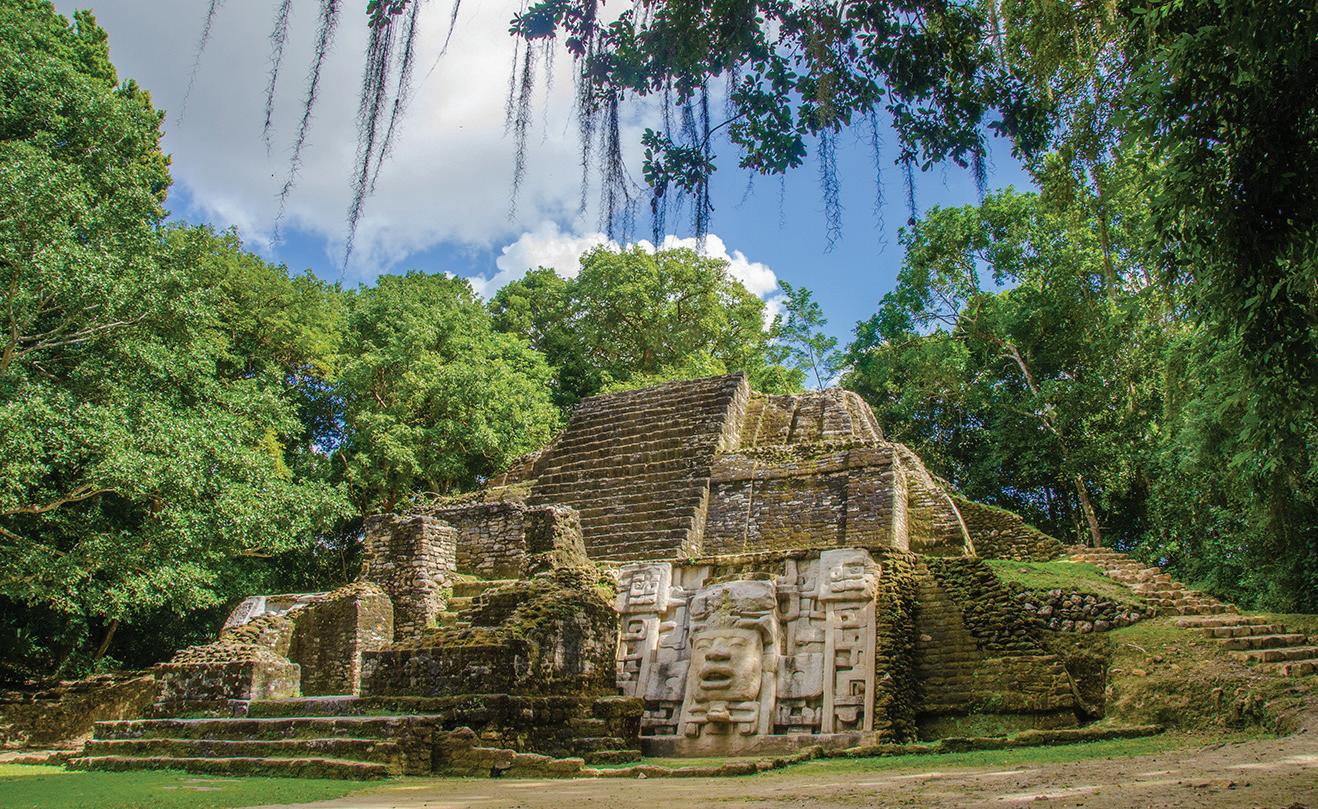
A New Direct Flight from Toronto to Jeddah
In December 2023, Saudi Arabia Airlines (Saudia), one of the 5-star airlines in the Middle East, reintroduced a direct flight from Toronto (YYZ) to Jeddah (JED), Saudi Arabia. Operating three times a week on a Boeing 787 Dreamliner, the air route allows travellers a new entry point into the emergent Saudi tourism industry and the landmarks of AlUla, Riyadh, Madinah, and the Red Sea.
11
Lions in the Bush
Artist: Negar Tavakol
There’s a texture to travel that words cannot capture. I created this original art piece as an homage to the textures of the African bush. Simple lines, tactile patterns, and earth tones come together to depict Africa’s most iconic animal, while the background comes to life with textiles from a quilt made in 2005 by the South

African art collective Ingubo Entle (which translates to “beautiful blanket” in Zulu).
This quilt is a beloved part of Goway’s art collection.
VISUAL TRAVEL


Responsible Safari Travel
Seeing animals in the wild is incredible, but helping to preserve natural ecosystems and support animal conservation is critical to ensuring a future for these majestic creatures. We caught up with Gina Dorey, one of Goway’s Destination Specialists, to get her expert advice on responsible safari travel.
What’s your favourite spot to view animals in the wild?
The Okavango region of Botswana, where humans are scarce and it’s easy to spot animals in their natural environment.
What’s a hidden gem?
In general, get off the main safari routes and head to more remote game parks. Botswana is one of the places in Africa that still feels completely wild.
What’s a great accommodation that promotes conservation and sustainability?
Mpingo Ridge Lodge in Tanzania, which has solar power and water filtration that allows them to work entirely off the grid and eliminate the use of single-use plastics.
What’s an essential safety tip?
Listen to your ranger when on game drives. They know the bush and are there to ensure the safety of you and the animals you encounter.
How can travellers minimize their environmental impact?
Stay at safari properties that recruit locally, have a large percentage of managers from local communities, source local food, and use no single-use plastics.
Are there any seasonal considerations to keep in mind when booking a safari?
The safari high season coincides with North American holidays so there are significant benefits to booking in the shoulder or low season. If you’re a birder, or really want to see the Great Migration, your Destination Specialist can arrange for you to travel during the optimal time to experience migrations.
What measures are in place to protect animals?
Reputable companies focus on educating guests to understand that wild animals need and deserve their own personal space to thrive. Responsible lodges train and empower their guides to never crowd wild animals, restrict visitor numbers, and work with authorities to combat poaching.
How can travellers actively contribute to animal conservation during their trips?
Avoid consumptive activities such as elephant back riding and canned lion experiences (Canned lions are bred in captivity, often for the purposes of hunting.). Rather, focus on community work that encourages local people to value the wildlife with whom they share their land, even though that same wildlife may pose a threat to their livelihoods.
13
ASK AN EXPERT
Moremi Game Reserve, Botswana
OFF THE BEATEN PATH
Songo Songo Archipelago, Tanzania
Find new meaning to “going off the grid” by visiting this island chain in the Indian Ocean.
WHERE IS IT?
The Songo Songo Archipelago lies off the Tanzanian coast 155 mi (250 km) south of the capital Dar es Salaam.
WHY SHOULD YOU GO?
This chain of five islands defines barefoot leisure. It has white–sand beaches, swaying palm trees, and pristine environments protected by a marine conservation area that allow endemic wildlife such as sea turtles to flourish. Individual islands such as Fanjove Island also have private resorts that let you escape beachgoing crowds, unplug, and unwind in a comfortable slice of paradise. There are few better ways to cap off a safari in the Serengeti or Ngorongoro Crater than with a few days on the beaches of the Songo Songo Archipelago.
HOW DO YOU GET THERE?
Fly from Dar es Salaam by small plane to Songo Songo Island. Transfer by dhow or speedboat if you’re heading to one of the other islands. Rely on Goway to arrange private transfers from the city to your chosen resort.

Fanjove Island boasts thousands of sea birds, nesting turtles, coconut crabs, dolphins, whales, and 11 km/7 mi of coral reefs.

You’ll find the best views of Fanjove Island from atop the restored 19th-century German lighthouse.
14


THE NIGHTCAP
The Sazerac
The original cocktail and the official drink of New Orleans.
No drink better captures the jazzy character of New Orleans than the Sazerac. According to legend, this libation was invented by the French pharmacist Antoine Peychaud, who would serve up this cognac-based drink in an egg cup or coquetier as an herbal tonic to promote his bitters. The drink became wildly popular, coquetier was mispronounced by local enthusiasts, and, voila, the word “cocktail” was born–of which the Sazerac is the world’s first. Traditionally made with cognac, modern Sazeracs see rye or bourbon replace the more expensive liquor, although the combination of Peychaud’s bitters, sugar, and absinthe or Pernod is essential to its full-bodied flavour.
For the quintessential Sazerac experience, head to the Art Deco Sazerac Bar in the Roosevelt Hotel in New Orleans. The bar was once a haunt of Louisiana’s notorious governor Huey Long, whose headquarters was a suite on the 12th floor.
15
The Sazerac Bar’s Art Deco design and mahogany bar embodies the elegant spirit and rich history of New Orleans.
Copacabana Palace, Rio de Janeiro
This Belmond property is a beachfront haven that epitomizes luxury and hospitality.

Resting along the mosaic Portuguese boardwalk and golden sands of iconic Copacabana Beach since 1923, Belmond’s Copacabana Palace in Rio de Janeiro stands as a testament to timeless luxury and sophistication. Follow the steps of Princess Diana, Madonna, and other cultural icons into the Art Deco halls of white and pink Brazilian marble to your choice of 239 luxurious rooms and penthouse suites.
Spend your days bathing on the sun–covered private beach or unwinding at the on-site holistic spa and salon for a complete wellness experience combining timeless healing techniques and postcard-worthy views. Watch the sun disappear behind the ocean from the open-air semi-Olympic-sized pool before indulging in the palace’s three restaurants, offering world-class fine dining Italian, Michelin-starred Pan-Asian, and experimental Mediterranean and Brazilian culinary experiences.

16
THE SPLURGE
Wildlife Memoirs
Get inspired to search for wildlife with these nonfiction tales of natural encounters around the world.



Birding Without Borders
by Noah Strycker
Considered one of the most influential recent books about birds, Birding Without Borders follows the author’s quest to see the most species of birds in a single year. Strycker’s journey takes him to 41 countries across all seven continents to spot 6,000 birds and learn more about the world than he could’ve ever imagined.
Cry of the Kalahari
by Mark and Delia Owens
This autobiography recounts the authors’ experiences living far from human habitation in the Kalahari Desert of Botswana in the mid-1970s. Cry of the Kalahari includes detailed observations of species such as lions, brown hyenas, and jackals, and continues to inspire readers about the remote wildlife of Southern Africa.
The Snow Leopard
by Peter Matthiessen
This 1978 classic follows the author’s search for a snow leopard in the Himalayas of the Tibetan plateau. Matthiessen’s work goes beyond detailing the natural world of this high-altitude region to reflect on spiritual matters and pose existential questions about humanity’s connection to the natural world.
17
RECOMMENDED
TESTED
A6 Memobottle
Its minimalist design and flat shape allow for easy travel.

There is no travel companion quite as important as your water bottle, and the A6 Memobottle is one you can rely on. Modelled after international paper sizes, Memobottle’s sleek, flat design allows for easy packing in any handbag, suitcase, backpack, and pocket.
All sizes come in either a BPA and BPS–free Tritan plastic or stainless steel model, both durable, lightweight, dishwasher safe, and suitable for hot and cold liquids. You can also personalize your Memobottle with a silicone or leather sleeve, adding some insulation and style to the simple, lightweight design.
Several functions and characteristics of the perfect travel water bottle were considered
when testing the A6 Memobottle, mainly durability, material, size, versatility, insulation, and an appropriate mouth opening. The A6 Memobottle excelled in all areas. One of our favourite features was that it easily fit inside our coat—and pant—pockets, allowing us to leave our bags behind when out for the day. We also felt confident sliding the bottle into our laptop sleeves next to our electronics thanks to its leakproof design.
$31 USD/ $43 CAD on memobottle.com
18
Amsterdam: Cityscape or Countryside
Whether you’re a city slicker or want to walk the country roads, Amsterdam offers numerous attractions within the city centre or a short excursion away.


Urban Rural
Visit the Rijksmuseum or Van Gogh Museum to see artistic masterpieces by Rembrandt or Van Gogh.
Rent a bike and explore along the canals en route to Vondelpark.
Learn about the history of Dutch beer at the Heineken Experience and follow it up with a pint of Heineken or Amstel (which is better than what you get abroad).
Explore Amsterdam’s famous canals on a boat cruise, which offers the best views of the city’s angular buildings.
Visit the famous Keukenhof Gardens to see millions of tulips in bloom.
Rent a bike to explore the trails and woods of Amsterdamse Bos, a sprawling forest south of the city.
Visit the open-air museum of Zaanse Schans to learn about clog making, taste artisanal Dutch cheeses, and, of course, see traditional windmills.
Take a boat cruise to the island of Marken to see its historic lighthouse and colourful stilt homes.
Indulge your sweet tooth with stroopwafels (waffle cookies) or feast on savoury bitterballen (crispy meatballs), two iconic Dutch treats.
19
1 DESTINATION 2 WAYS
Rijksmuseum Keukenhof Gardens
BOOK AHEAD
Melbourne, Australia in January
One of Europe’s hottest destinations is only growing more popular.
January is one of the most beloved seasons in Melbourne, and deservedly so. The city offers seemingly limitless activities and events for everyone to enjoy in the heat of summer. Discover Melbourne’s celebrated street art as you wander through the iconic Hosier Lane before indulging in the plethora of renowned cafes, restaurants, and bars lining the banks of the Yarra River. Enjoy the city’s dynamic atmosphere by exploring community events such as watching a movie at the Moonlight Cinema in Melbourne’s Royal Botanical Gardens or celebrating the Lunar New Year at one of the world’s oldest Chinatowns.
Melbourne also kicks off the tennis Grand Slam schedule with three exciting weeks of the Australian Open. Seize the once-in-a-lifetime opportunity to watch the world’s best tennis players duel it out and embrace the festivities of one of the premier sporting events of the year. January in Melbourne is hard to beat, but make sure to book ahead to beat the frenzy.

20
Flinders St Station, Melbourne, Australia


APT by Goway
Award-Winning Tours Delivered by Industry-Leading Travel Experts
APT is a leading operator of luxury coach tours and once-in-a-lifetime rail journeys across Australia & New Zealand. Goway is the exclusive provider of APT’s extensive selection of award-winning tours.
APT by Goway is your way to experience the magical landscapes, friendly faces, and unforgettable connections that await you in Australia & New Zealand.
Explore Luxury Escorted Vacations
aptouring.com

A Beginner’s Guide to Birding & Travel
Like travel, a passion for birds leads to a broader curiosity and care for our natural world.
WORDS AREN BERGSTROM
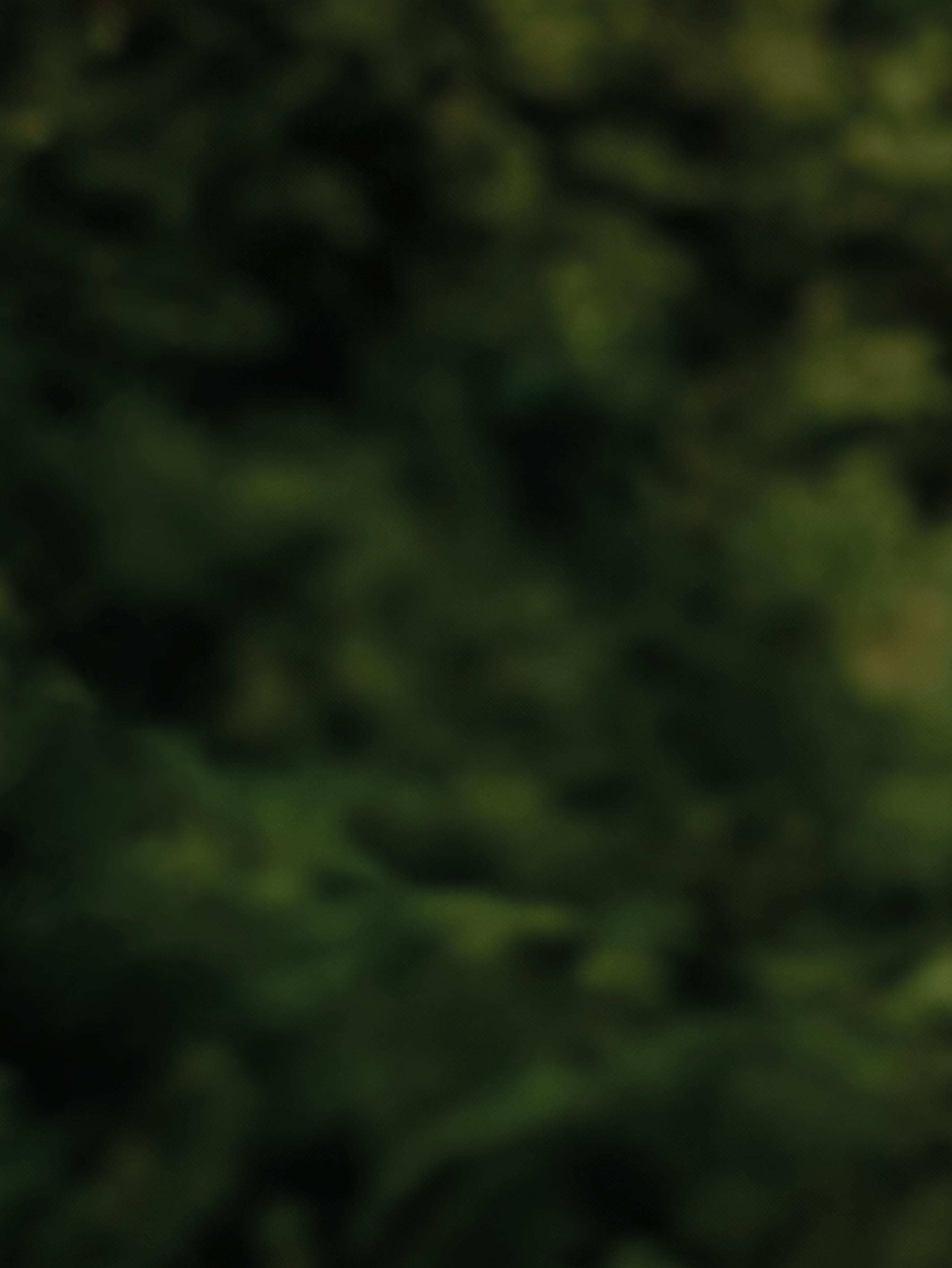
It all starts with a flash of colour and a piercing note in the morning air. It’s just after dawn and the rising sun streams its golden rays over the deep greens and blues of the Pacific coastline of Manuel Antonio. Two scarlet macaws, brilliant parrots with red, blue, and yellow wings, glide across the horizon right to left.
I had come to Costa Rica for the warm sun, cool waters, and dense rainforests full of three-toed sloths, but it’s the birds, like these scarlet macaws, that make my trip truly special. Travelling the world is one of the great pleasures of life. Birding is something that heightens that pleasure. The two are natural pairs, twin passions that help you engage with the world around you.
Birdwatching, known as birding to enthusiasts, is one of the fastest growing hobbies in North America. If you’ve ever spotted a bird in a local park and looked up which species it is in a nature guide, you’ve technically gone birding. There’s no right way to bird. Simply paying attention to birds is all that is required.
The pandemic turbocharged the public interest in birding. People were bored during lockdown, so they started to pay attention to all the birds in their local parks and backyards. This attention turned to affection and then to passion. Looking for birds wasn’t just a way to pass time. It became a meaningful way to engage with the natural world.
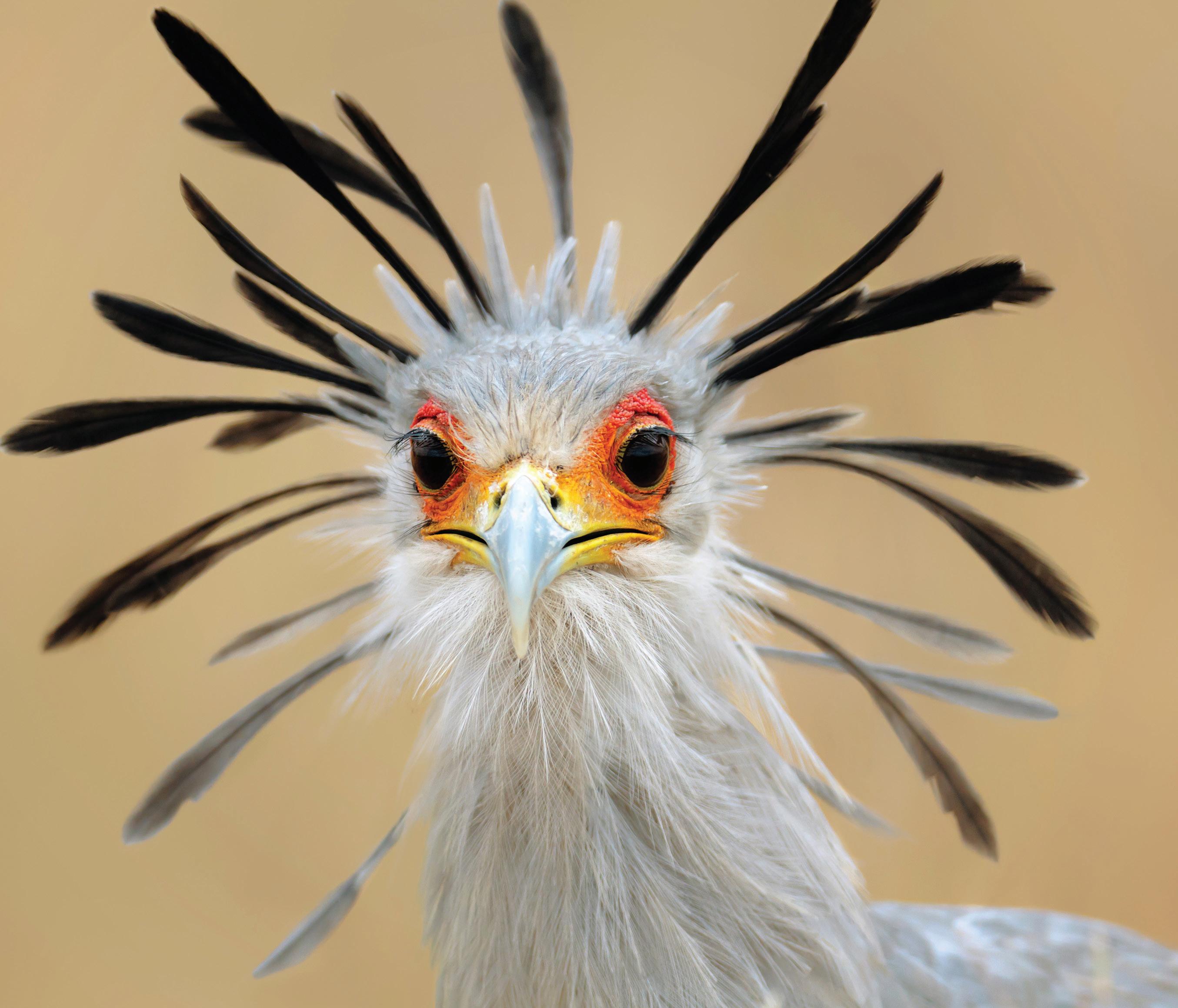
Many people share this passion with others, whether in local organizations or online forums. The most popular such tool is eBird, a free, online database managed by the Cornell Laboratory of Ornithology. On eBird, users log bird sightings according to date, species, and location. More than 900,000 people have contributed data to eBird, with 340,700 people contributing data in 2023 alone.
A Birder’s Essential e-Tools
Jenna Curtis is Project Co-Leader of eBird and oversees outreach and communications with the eBird community. She’s also an avid birder herself and uses eBird data to discover birds on her travels. “We recently got to take a family trip to Africa,” Jenna explains, “and one of the birds that I really wanted to see was a secretary bird, a tall, long-legged bird, which specializes in stomping on and eating snakes. It’s got this neat, feathered quill–like head. I was just so excited to see it.” In preparation for her trip, Jenna searched for secretary birds in Botswana on eBird and the Explorer tool displayed a heat map of all the sightings in
the nation. She could then filter to see the most recent sightings and clusters of the most common sighting areas.
Merlin is the other most common birding tool available. Also created by the Cornell Laboratory of Ornithology, the Merlin app works in conjunction with eBird data to help you determine what bird you’ve seen in the wild. Merlin walks you through identification based on distinguishing characteristics such as colour and beak and then determines which bird you saw. It can even record audio and help identify birds through calls and songs. Since inception, Merlin has helped 16-million users identify 9,064 individual species of birds.
Merlin also helps travellers get a general sense of what birds await on a journey to a foreign land. “Say I’m going to Victoria Falls, and I want to know what birds I’m going to find there,” says Jenna. On Merlin, “I can actually explore the birds for that particular location so that when I go there, I know what birds to be on the lookout for and what they look like.”
24
Mid–February to July is the best time to find Resplendent Quetzals in Costa Rica.
The Secretary bird is endemic to sub-Saharan Africa and nicknamed the archers of snakes.
Twin Passions of Birding & Travel

While passion for birds increased during the pandemic, birding has long been a beloved hobby. BirdNote is a media project that shares facts about birds through various syndicated radio programs and podcasts, while also spearheading conservation efforts. “By telling vivid, sound-rich stories about birds and the challenges they face,” its mission states, “BirdNote inspires listeners to care about the natural world—and take steps to protect it.”
Dan Moore is Board President of BirdNote. A travel guide and consultant by trade, Dan came to birding relatively recently in 2018, when reading Noah Strycker’s Birding Without Borders inspired him to buy his own pair of binoculars and head out to spot birds in the Pacific Northwest. Travel had lost its excitement for Dan, but birding reignited it: “I was taking for granted the privilege that I had to be out travelling and birding turned that all around. I got more excited to travel again because I was going to see new birds.”
Dan’s own experiences prove how naturally birding and travel fit together. Birds inspire us to pay attention to the world around us and learn about the natural ecosystems we observe, while travelling takes us to faraway places, which helps us encounter new birds and learn about new ecosystems. Both activities take you outside of yourself and help you engage with the world around you.
The Birder’s Bucket List
One concrete approach that both birders and globetrotters share is list making. Birders call it a life list, travellers a bucket list, but both are the same: a concrete list of all the birds or places one wants to see or explore in their lifetime. Birders want to spot a resplendent quetzal in the cloud forests of Costa Rica or a bird of paradise in the remote jungles of Papua New Guinea the same way that travellers want to snorkel the Great Barrier Reef in Australia or hike the summit of Machu Picchu in Peru. Both passions become a means of organizing one’s life and prioritizing meaningful experiences.
25

For both birders and travellers, it’s not just about checking the item off the list, but the accompanying sense of accomplishment and memory making. “Every bird on a list is a memory,” says Jenna Curtis. “It’s an experience. It’s not just that bird; it’s the 10-hour hike and the rain and the food. And the people that you were with. Every bird on a life list is all of those things as well. When you’re able to look at that list, and be able to have those memories that go with it, it’s like a scrapbook, right? It’s a trip down memory lane to be able to do that. It’s so much more than just that checkbox.”
Birding as a Gateway to the World
Searching for birds in other parts of the world also presents the possibility to learn more about the world. Birds are an entry point to the totality of a place and its culture. They’re just one part of the ecosystem, both naturally and culturally.
“I had work in Italy and I hired a local bird guide there,” says Dan Moore. “And I spent the whole day with him, just me and him. And, of course, I gravitated to many subjects like politics and the economy. I felt like because I spent a whole day with this guy and birds can only cover so much of that day, I ended up learning way more about Italy than I would have if I just rented a car and got out there on my own.”
Like travel, birding is a means to an end, not an end in itself. “Birds have the power to unite people towards conservation goals and the appreciation of nature,” says Jenna Curtis. “Everything you learn about a bird or see about a bird helps you to appreciate the environment that it’s in, and what makes that place unique.”
Travel inspires us to expand our thinking and appreciate the variety and diversity of life. Birding inspires us to understand how all the mundane elements of an ecosystem coexist and how important environmental sustainability and conservation are to preserving these beloved environments. Like the burst of red, yellow, and blue on a scarlet macaw against a coastal backdrop, birds can elevate the travel experience and transform it into something that inspires, challenges, and fulfills us.
26
You’ll likely find lilac-breasted rollers in acacia-rich landscapes featuring widely spaced trees, bushy game lands, riverbanks, and cultivated areas.

WILD ENCOUNTERS
5 Unforgettable Adventures in Tropical North Queensland
Step into Tropical North Queensland to uncover nature’s transcendent past and present.
WORDS SAEL FORSTER
Great Barrier Reef Rendezvous
It’s hard to stand out from the crowd when you live in the Great Barrier Reef. The spectrum of symbiotic wildlife and vibrant colours you’ll find within this iconic seascape offers endless discovery. Float above gliding manta rays in a glass-bottom boat, dive into meet-cutes with ancient sea turtles, and marvel at leaping humpback whales. A visit to the Whitsunday Islands proves life above the reef is equally exciting, with tropical birds, mammals, and reptiles you can find in the wild and on safaris.
Daintree’s Legacy of Apex Predators
Daintree Rainforest’s ancient saltwater crocodiles will be happy to know their descendants are doing them proud as earth’s largest living reptiles, surviving for over 65 million years. A tour along the Daintree River or to the Australia Zoo will bring you as close as you’ve ever been to these ancient apex predators, coexisting with their human neighbours throughout the world’s oldest rainforest.
Rave at Kuranda Rainforest Village
Very few dances are as mesmerizing as the ones performed at the Australian Butterfly Sanctuary and Birdworld Kuranda. Watch more than a thousand tropical butterflies float weightlessly across
lush gardens and listen to the symphony of one of Australia’s largest collections of free-flying birds, including prehistoric southern cassowaries and striking black cockatoos.
Atherton Tablelands Bird Search
If you’re more interested in finding the southern cassowary in its natural habitat, head straight to the untouched, rainforest–covered mountains of the Atherton Tablelands. This incredibly diverse region is home to nearly half of Australia’s 726 bird species. Follow a passionate guide into the heart of one of Australia’s most important bird meccas and discover the sounds and stories of some of the world’s most unique birds.
Dreamtime at Mossman Gorge
Discover the human connection to the Daintree Rainforest with the proud guidance of the indigenous Kuku Yalanji people who’ve inhabited Mossman Gorge for 50,000 years. Embark on a Dreamtime Walk and discover the stories and legends steeped in the rainforest and the local community.
27

28
Jeffry Garriock films snowy owls in Amherst Island, Ontario. Photo: Imogen Prince
Behind the Camera with a Natural History Cinematographer
The best view in the house is not for the faint of heart.
WORDS MITCHELL FAWCETT
“So, what do you call yourself?” I open our interview with this question even though I’ve called my interview subject a friend for nearly a year. He is a true multi-hyphenate, observing the natural world through many lenses. “Natural history cinematographer” best captures the role of Jeffrey Garriock. His work is very much part of a scientific field of study—one where observation ranks higher than experimentation. He just so happens to observe with expensive and elaborate camera equipment. He tells me this title reflects his respect for nature and wildlife, and how that drives his work. It also drives his dietary preferences, so we have this conversation over dinner at a vegetarian restaurant in Toronto.
As a child, the bright yellow covers of National Geographic drew Jeffrey into an early education of the natural world. He was fortunate to accompany his father on a scuba trip to the Great Barrier Reef at just 13 years old. A videographer joined the dive, and after seeing the footage, Jeffrey’s passion was forged. Over 20 years later, his IMDb credits now include camera operator, photographer, cinematographer, and director. He has filmed the Antarctic Ocean, the plains of Africa, and even the Chernobyl nuclear exclusion zone.
Iconic series like BBC’s Planet Earth and Blue Planet have set new standards for wildlife documentaries, captivating viewers with incredible footage. Mere seconds on the screen can take days to capture. Jeffrey once spent nine days in the cold for a single shot of a polar bear and her cub emerging from their den. An unexpected phytoplankton bloom in the Eastern Tropical Pacific once interrupted his production for three days. He muses about spending 12 days in the wild Ontario north chasing the elusive snowy owl without capturing enough footage for a single segment. Nature is known for going off-script. The thrill of the hunt is part of the adventure, and one must take these setbacks in stride.
Legitimate occupational hazards are much more seriously considered. “The first priority is safety. The second priority is safety. The third priority is capturing great footage.” Jeffrey (bravely) doesn’t consider his work dangerous, but he is acutely aware that it has more hazards than most. Preparation is everything, and it can take a team of scientists, researchers, producers, fixers, and assistants to plan a safe and effective shoot. Underwater shoots are especially complex. An unexpected ocean current once caught
29


a teammate while filming whale sharks near the Galapagos Islands. Preparation, training, and diligence made for a quick search and rescue in under an hour. He (again, bravely) considers this exploring one’s limits, not necessarily pushing them.
With such a diverse portfolio of work, travel is a constant. I clocked an Aeroplan Elite luggage tag on Jeffrey’s equipment bag when we first met on a shoot in Rwanda. He has certainly logged many miles—intrepid exploration of the globe is part of the job. When it comes to a new project, “the less I know about where I’m travelling to, the more excited I am.”
The travel is exciting, but what clearly drives Jeffrey is conservation above all. The effects of climate change come into sharp focus in his day-to-day. In front of his eyes, animal behaviours are changing and weather patterns are becoming less predictable. The scientists and researchers that he works side-by-side with are doing important work as guardians of the environment. He humbly regards himself as their storyteller.
Together, they advance research, change conversations, and add to the sum of human knowledge. He has even been there to document the discoveries of new species—what he considers to be the “wildest” of experiences that comprise his job description.
Jeffrey’s intimate and courageous relationship with the natural world is enviable. He tells me about his first trip to Iceland, the country known as the Land of Fire and Ice. To him it felt just as fantastical as the mythical worlds in his favourite novels. Diving between tectonic plates in a country with 32 active volcanoes truly doesn’t faze him. He does regard the ocean with deep reverence. “I always remember that we’re guests underwater, and we can only visit for a very short time.” It’s where his most ambitious personal and professional growth will continue to unfold. It’s also the most uncharted frontier for any adventurer.
Whether underwater or in the canopies of mountainous jungles, Jeffrey is right where he should be: in a front row seat to a world of wonder where almost nothing is off limits.
30
A penguin colony on a free–floating iceberg in the Antarctic.
Photo: Jeffry Garriock Filming whale sharks in the Galapagos. Photo: Sofia Green

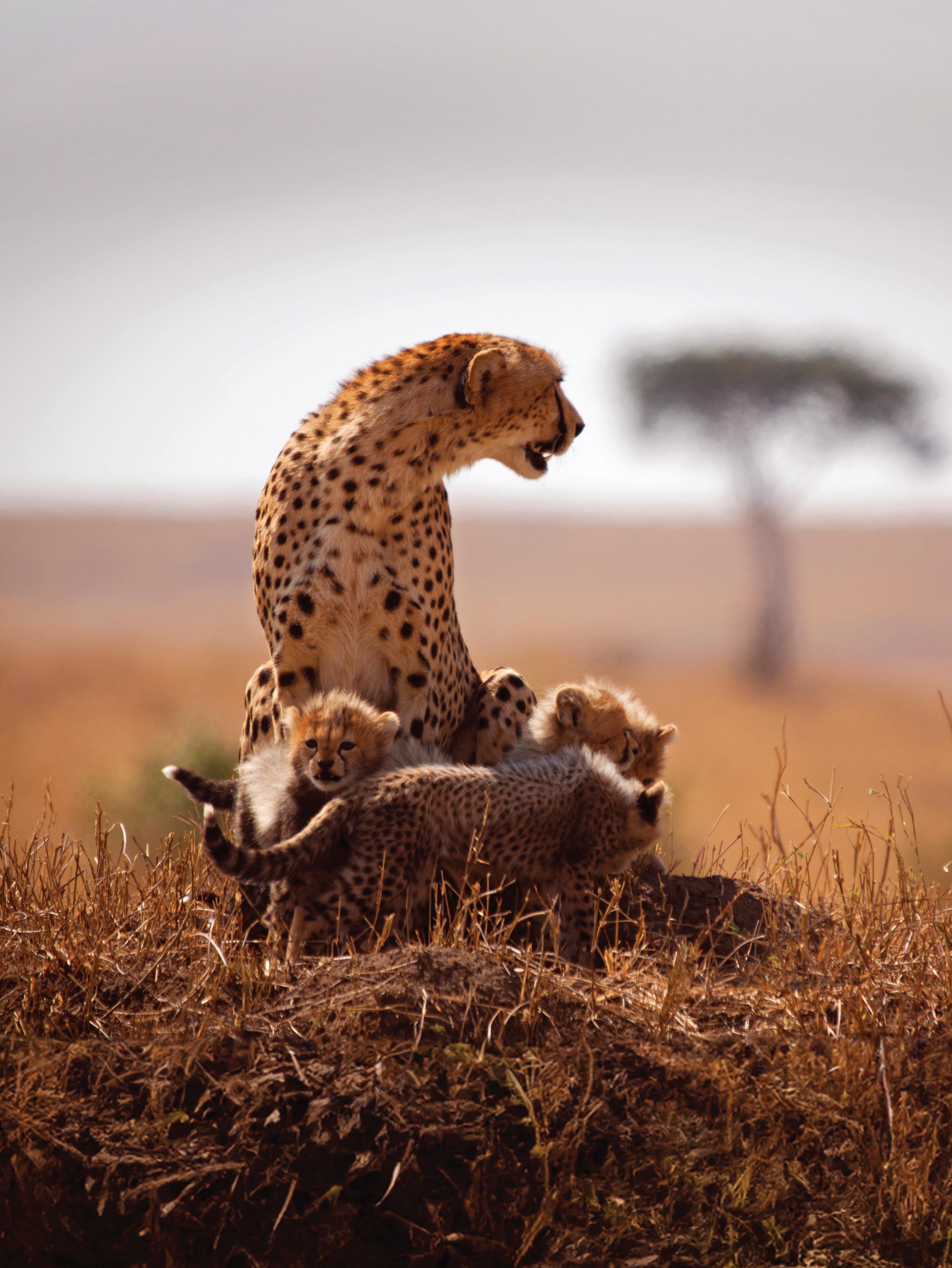 You can find cheetahs hunting in open grasslands and savannahs on safaris across Africa.
You can find cheetahs hunting in open grasslands and savannahs on safaris across Africa.
My First African Safari
Whether it’s your first safari ever, or your first safari in a new country, the thrill of seeing African animals in the wild will stay with you forever.
WORDS MOIRA SMITH

My earliest memory of going on safari was when I was a little girl, no more than eight years old. I was born and raised in South Africa, so my family were no strangers to safari. But it was new to me at the time, and I’ll never forget the thrill of seeing life in the bush play out before my very eyes.
My family and I were in Kruger National Park—spending time in South Africa’s most famous game park in the country’s northeast is a favourite pastime for South Africans of all stripes. As the day progressed, we came across a cheetah stealthily walking along the side of the road. The cheetah’s every step was silent, its paws carefully moving forward in the bush alongside the road. I looked to see where the cheetah was headed and spotted a small herd of impala grazing absentmindedly in some tall grass. They didn’t realize the danger, until they did. The silent cheetah exploded out of the bush and the herd scattered. One unlucky impala fell to the teeth and claws of the cheetah. It was too fast, the course of nature too inevitable. Not every first memory on safari is a matter of life and death like mine was, but that first encounter with the realities and magnificence of the wild sears itself into your mind.
Animals are always living out the great cycle of life and death all around us, but usually they’re just outside of view. There’s too much that obscures them: chores, bills, day jobs, mundane worries, emotional matters big and small. We don’t usually have the chance to pay attention to the great wild that coexists alongside us, but safaris strip all the stuff of urban life out of the way. They force us to see the wild up close and realize our own place within the grand ecosystem of life. An African safari lets you escape and disconnect from the everyday, and in doing so connect with the wild earth.
Safaris also help you connect to communities that live at a different rhythm than most of us do. They also contribute to local communities and provide insights into diverse African
cultures and traditions. Perhaps most importantly, they contribute to conservation and environmental protection. Most people love lions, elephants, and giraffes, but as abstractions more than real beings sharing the world with us. But when you see these animals up close, the stakes of losing them become tangible. You realize you must do something to protect them for future generations. Seemingly inconsequential things like park fees become important means of supporting and protecting wildlife in nature reserves and national parks.
If you’ve never been on a safari before, I envy you. There’s nothing like the first time you head into the bush on your first game drive and enjoy that glimpse of a lion’s mane in the tall grass or the ears of a hippo peeking above the surface of the watering hole.
There are a few essentials to keep in mind before you go. First, choose the right time to travel. If you’re a keen birder or want to see the Great Migration in the Masai Mara and Serengeti, seasonal migration patterns will determine when to visit. Second, realize that Africa is not homogenous. It’s startlingly diverse so think about what you want to do on safari and then determine the right place to do it. It’s essential to rely on the expertise of your Goway Destination Specialist, who has gone on safari before and planned countless more for other travellers.
Finally, realize that African safaris are transformative experiences. They offer a chance to reconnect with nature, witness the circle of life, and experience the primal beauty of our planet. And they give us tangible opportunities to support local communities and connect our unforgettable travel memories to the preservation of our most precious creatures. In essence, safaris are natural experiences, but they also take on spiritual dimensions. They change you for the better. The hope is that they help you change the world for the better, too.
Our Unforgettable First Safaris
You never forget your first—our team certainly hasn’t. Let these safari memories from Goway team members inspire you to follow in their footsteps and enjoy the timeless appeal of an African safari.

Incredible Wildlife Diversity in the Land of a Thousand Hills
MITCHELL FAWCETT, VP Marketing
Rwanda is widely regarded as an ideal gateway into Africa for first-timers, and I certainly see why. It’s clean, safe, easy to navigate, and even requires fewer vaccines than many other countries on the continent. The warm and effusively welcoming spirit of the locals instantly put me at ease.
I was struck by the extensive biodiversity of the small country. It’s less than a day’s drive from the west’s soaring mountains, through the central rolling hills, and into the arid plains of Akagera National Park in the east. The lush mountain forests are most famous for the endangered mountain gorilla, but they also house 12 other primate species. As we trekked through Nyungwe National Park’s trails and rope bridges, there was a constant symphony

of monkeys and birds in the treetops that felt reminiscent of the Costa Rican jungles I know and love.
Just 155 mi (250 km) to the east was a striking transition into the landscapes I’d been yearning to see since watching The Lion King for the first time—acacia trees, red clay soil, and pale dancing grasses flanked by mirror-like lakes. We arrived just in time for a sunset cruise on Lake Ihema, dotted with hippopotamus ears. Just 15 minutes in we were stunned to cruise past a duo of bathing elephants. Two days of game drives followed where we easily crossed off the Big Five, and many more. Seeing such an array of wildlife in their pristine, natural habitats was moving beyond words. Africa, I’ll be back.
34
Face-to-Face with Giants in Hwange National Park
KELLEY CLEAVELAND, Destination Specialist
Zimbabwe is most famous for Victoria Falls, but Hwange National Park is an exceptional safari game park. I had been to neighbouring Zambia before and seen Victoria Falls, which sits on the border between the two nations, so I had a sense of the country’s geography and attractions, but I was amazed by the size and diversity of the park.
Hwange lies on the edge of the Kalahari Desert and the landscape of the park rapidly transforms from dry riverbeds and mudflats to swamps and lush forests. We visited in the green season in May when the humidity and rain led to trees bursting and soils rich with nutrients and moisture. The whole country was flush with life and we saw so many animals every day. Zimbabwean safari guides go through rigorous training, safety, and aptitude tests, which meant we
could go on walking safaris. We easily spotted most of the Big Five (rhinos hadn’t been introduced into Hwange yet when I visited).
But it’s the elephants that are most notable in Hwange. Hwange has the largest population of elephants in the world after Chobe in Botswana, so we saw them in great numbers throughout the park. At one point on a walking safari, we encountered a great group of elephants drinking from a waterhole. We watched them and they watched us, each group wondering whether it was necessary to worry about the other. It was a remarkable encounter that put us face-to-face with magnificent giants and let us witness what remarkable minds they have. If you have the chance to visit Zimbabwe, don’t pass it up.
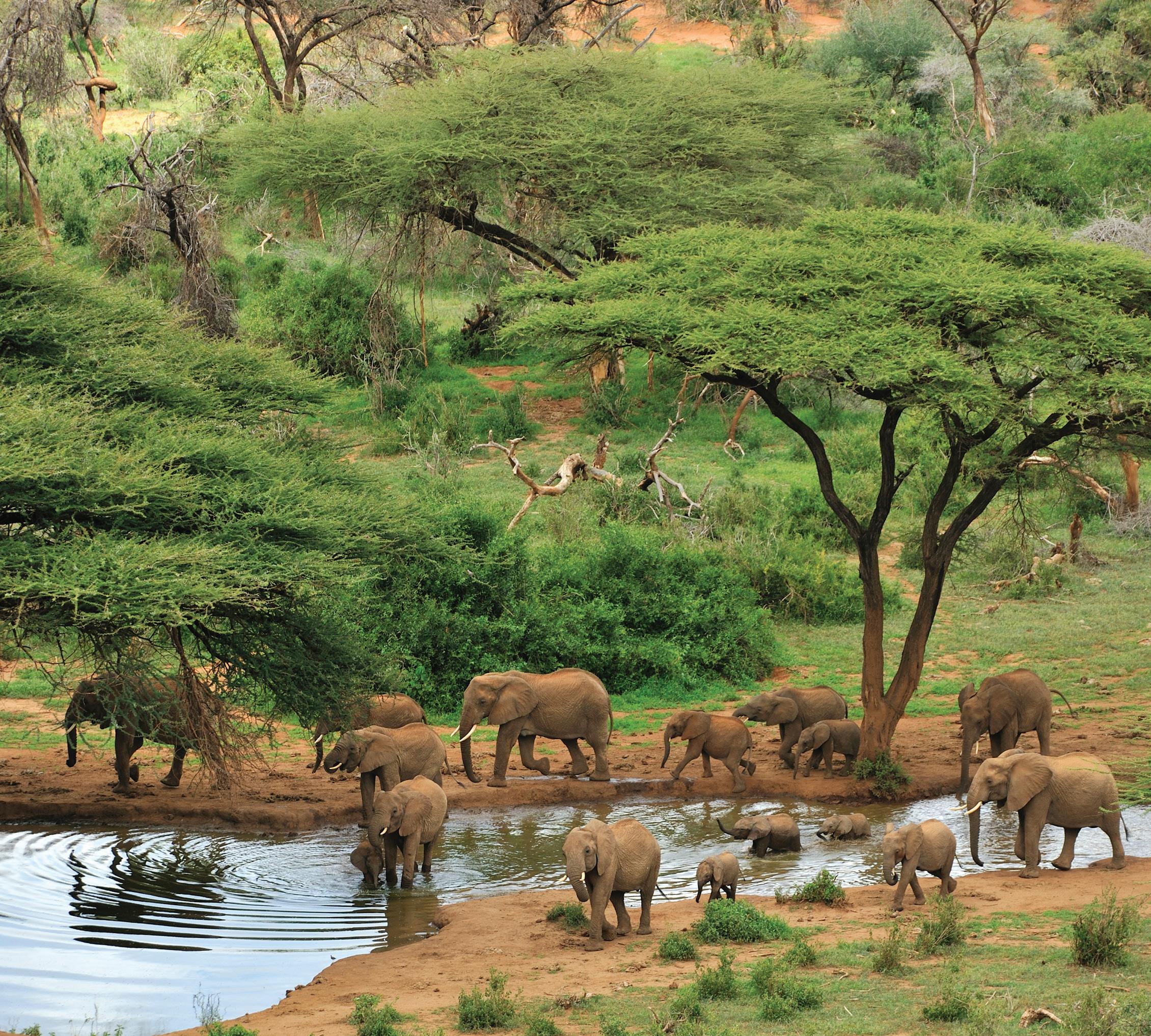
35

Iconic Sunsets & the Big Five in Sabi Sands
LAURA VAGNERS, Destination Specialist
I went on my first safari to Sabi Sands, a private game reserve on the edge of Kruger National Park, South Africa.. The area is renowned for the high density of wildlife. After our first afternoon when we saw all the Big Five, I realized just what they meant by density. I didn’t think it could get any better, but every day outdid the last.
Our first game drive was thrilling. I had no idea what was around the corner when driving through the unspoiled bush. The first sight of a lioness and her cubs and a herd of elephants took my breath away. I had to put my camera down and just soak in the immersive experience. We split our time between game drives and walking safaris, which let you experience the
land intimately. Every plant, footprint, and smell told a different story about the ecosystem and the interconnectedness of life. We typically ended each day with sundowners: an ice-cold local drink, some snacks, and the incomparable colours of the African sunset.
I will always remember the passion of the staff, guides, and trackers. They were committed to providing the best experience and sharing their knowledge and passion with us. The guide’s stories highlighted how every antelope and bird was remarkable in its own way and critical to ensuring the stability of the larger ecosystem. I left a little piece of myself in this land, and 10 years later, the experiences remain clear as day in my mind.
36
Mokoro Rides in the Okavango Delta
MEG SMITH, Reservations Supervisor
Botswana is renowned for its elephant population. There is even a road leading to the Zimbabwean border nicknamed the Elephant Highway and the area lives up to its name, with elephants everywhere. But the safari experience does not end with elephants in Botswana. This is a nation with a shifting landscape, from the dry deserts and salt pans of the Makgadikgadi Salt Pans in the south to the lush wetlands of the Okavango Delta to the riverside parks of Chobe in the north.
In the Okavango, we would ride in a mokoro (traditional dugout canoe) and glide through the waters, spotting wildlife on our left and right. The wetlands are bursting with birdlife: Botswana’s national bird, the lilac-breasted rollers with their plumes of pink, blue, and orange; the long legs and necks of kori bustards, the largest flying bird native to Africa, and countless other migratory birds. This is a birder’s paradise! In the Okavango, we also went on walking safaris and at one point saw a large bull elephant. It’s a different experience seeing them outside of the vehicle. It gives you a true sense of how large they are and makes you feel so much more a part of the environment.
The diversity of Botswana’s landscape also makes it possible to spot rare wildlife. On a sunset game drive in the Makgadikgadi Salt Pans, after searching for flamingoes on a soda lake and enjoying sundowners, we were leaving the park and an aardwolf darted in front of our vehicle. These animals are remarkably rare. This moment remains the only time I’ve seen one in the wild, despite many more game drives across Africa in the years since. It shows just how special Botswana is and how magical a first safari can be.

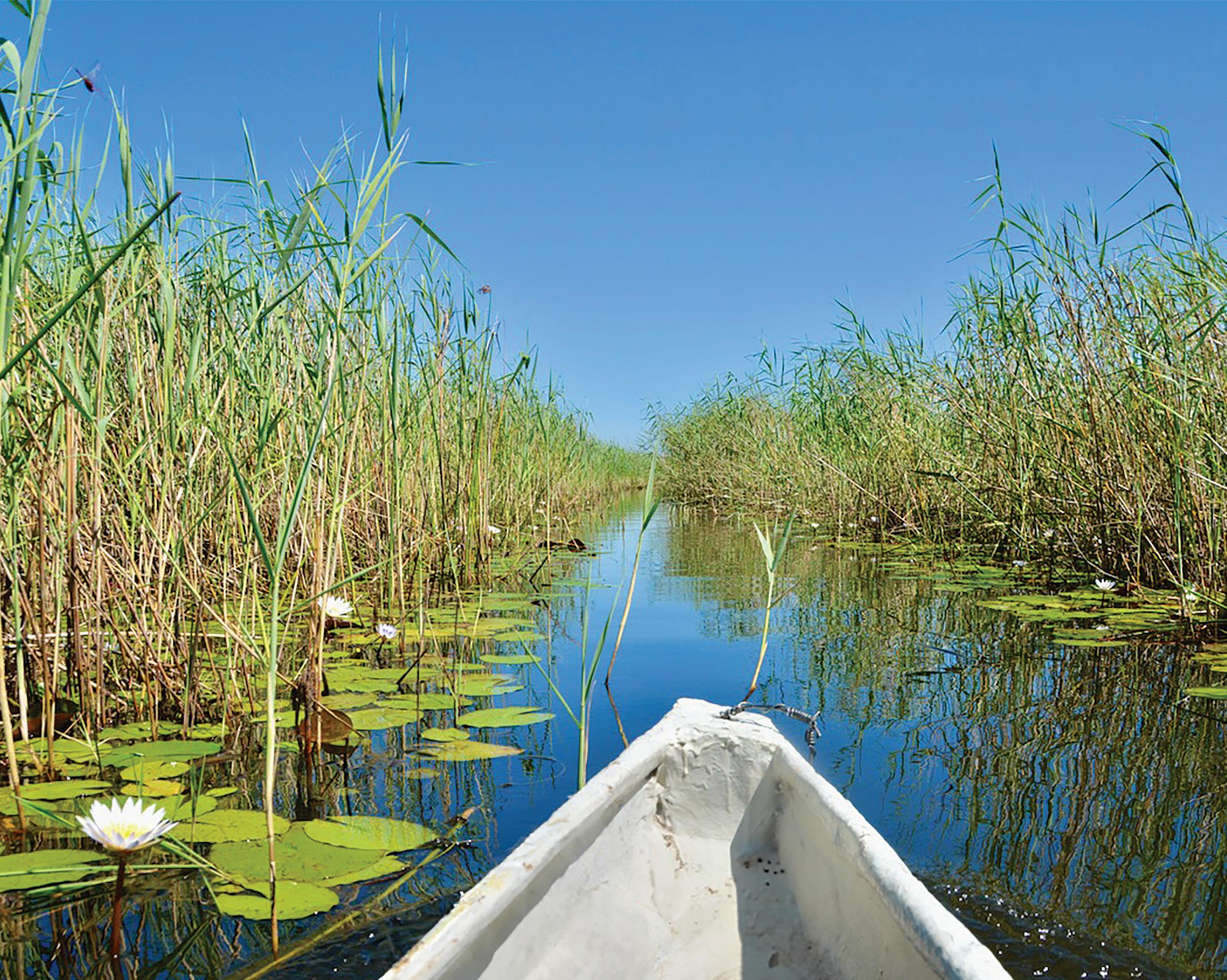
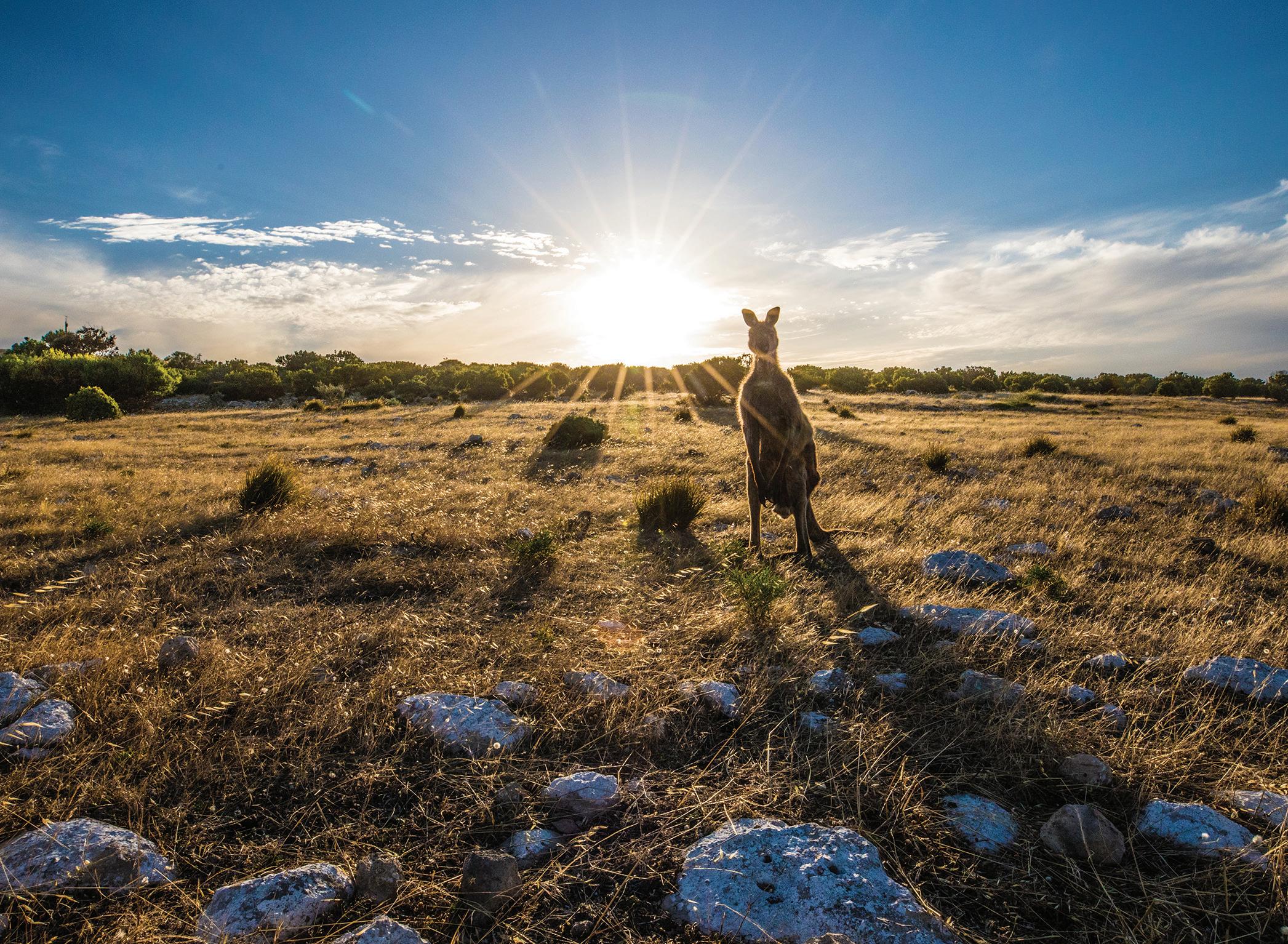
Kangaroo Island Bounces Back
The biodiverse Australian paradise is seeing positive signs of recovery after the damaging wildfires of 2019 and 2020.
WORDS
DANNY SINOPOLI
When devastating bushfires consumed large swathes of Australia in 2019 and 2020, one of the hardest hit areas was Kangaroo Island, a wildlife-rich tourist haven some 8.6 mi (14 km) off the coast of South Australia. Over nearly three weeks, more than 810 sq mi (2,100 sq km) were scorched, and the Southern Ocean Lodge, an iconic clifftop hotel considered the pioneer of experiential luxury on the continent, burned to the ground. The latter’s destruction was a particularly ominous blow to a tourism industry also about to endure the COVID-19 pandemic.
In the intervening years, however, Kangaroo Island has bounced back remarkably. At the end of 2023, the Southern Ocean Lodge reopened, heralding the latest milestone in the island’s ongoing recovery. In addition to augmenting its reconstructed guest suites and main building with new solar power technology and fire-retardant landscaping, the resort
introduced a new ultra-premium suite, the 6,888 sq ft (640 sq m) Ocean Pavilion, which offers panoramic views of the Southern Ocean from a super-private new perch.
SOL 2.0, as the restored lodge playfully calls itself, is located on the southeastern edge of Flinders Chase National Park, home of the Remarkable Rocks and other geological wonders. It, too, is once again open to visitors, complete with brand–new infrastructure designed to optimize their connection to the island’s diverse wildlife, from the abundance of kangaroos, koalas, and wallabies to its resilient native plants. Fans of marine life, for instance, can take in the still-thriving colony of long–nosed fur seals at Remarkable Rocks via a new boardwalk, while a modified version of the world–famous Kangaroo Island Wilderness Trail, a trek of up to five days, is accessible to walkers who book through licensed
38
tour companies such as Goway. Shorter trails are also in place at Ravine des Casoars Wilderness Protection Area and at Cape du Couedic.
On the opposite end of the island, at its easternmost tip, Sea Dragon Kangaroo Island, which bills itself as the only full-service boutique property on the island, is the place to be for indulging in flora, fauna, sea views, and beach life. At least 30 of the island’s 260 or so bird species, for example, can be found on its secluded coastal grounds, making it a birdwatcher’s paradise. The eco–sensitive lodge has also been involved in the development of the new Dudley Peninsula and Cape Willoughby walking trail, a “fantastic addition” to Kangaroo Island’s already extensive network.
In the language of the Indigenous Kaurna people, Kangaroo Island is known as Karta Pintingga, which translates literally as Island of the Dead. Four years ago, that moniker was an apt one,
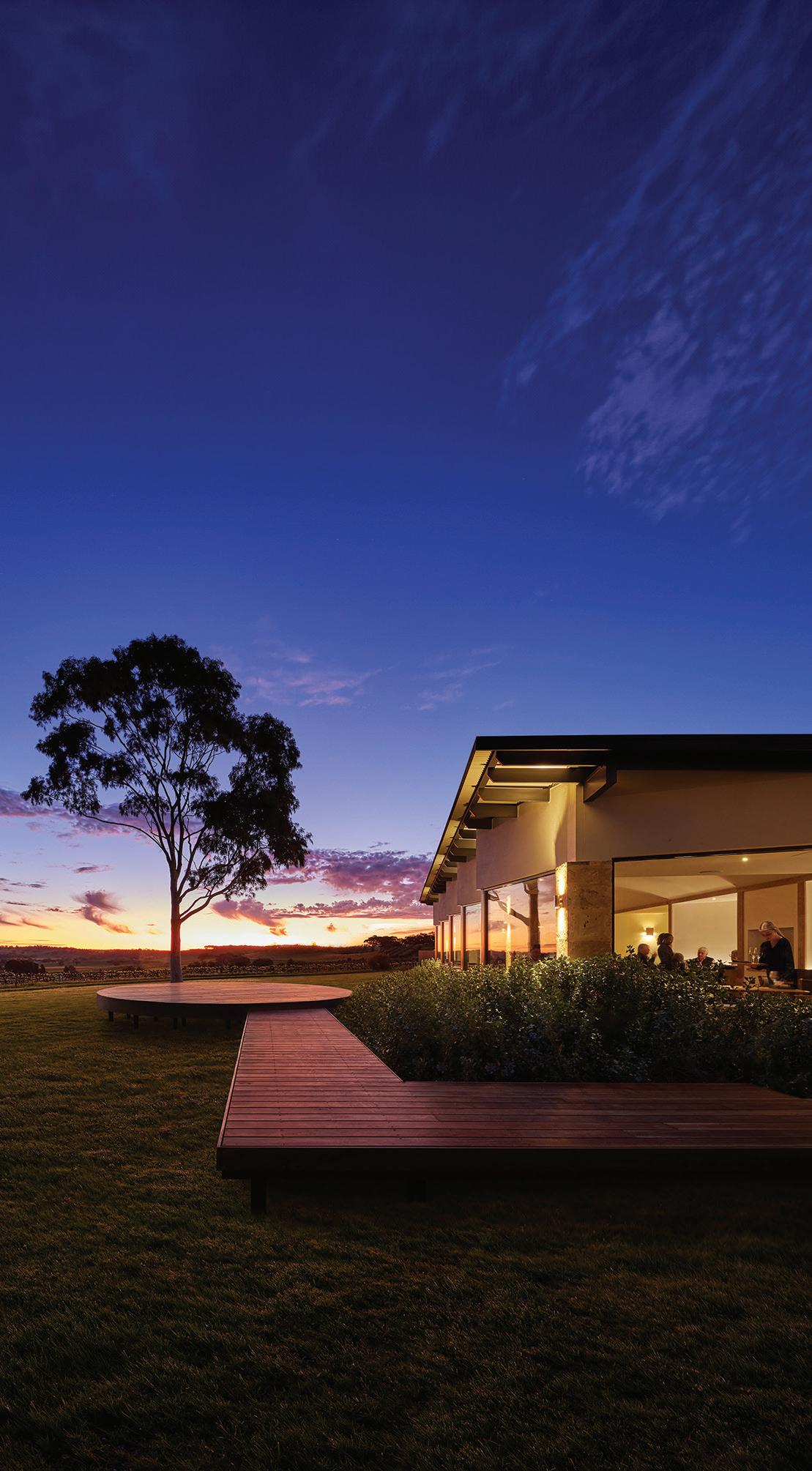

but the destination has since experienced rebirths on multiple fronts. While the island’s hotel properties have been subtly repositioning their suites or modifying their landscapes to take greater advantage of location and views, South Australia’s Parks and Wildlife Service is also grasping this “unique opportunity… to reimagine visitor experiences,” whether it’s enhancing engagement with plant and animal life or making more effective use of citizen scientists.
What won’t change, of course, is the rugged beauty and universal value of this island sanctuary, known quite rightly as the Galapagos of Australia. The time to visit is now.
39
A 20-metre wilderness buffer of fire-retardant native succulents and endemic junipers surrounds the lodge.
Kangaroo Island kangaroos are nocturnal herbivores, grazing in the early morning and afternoon.

Beauty of the Beast: Scottish Highland Cattle
Wooly Highland cattle epitomize the indomitable spirit of Scotland.
WORDS ERIC HENDRIKX
In the rugged tapestry of the Scottish Highlands, where the earth whispers ancient tales to those who dare to listen, roam creatures that are as enigmatic as they are majestic—Highland cattle. These beautiful beasts, with their formidable horns and woolly coats, are the living embodiment of Scotland’s wild heart. They are as much a part of the landscape as the rolling hills and the heather that paints the ground purple. To witness these animals where they hold court, grazing amidst Scotland’s towering mountains, endless skies, and the deep, mysterious lochs, is to connect with something ancient and timeless, a sentient link to when the world was younger, wilder.
Highland cattle, or “Heilan coos” as they’re affectionately known in Scots, are not just livestock—they are icons of Scotland, symbolizing strength, resilience, prosperity, and the enduring charm of the Highlands. Their hardiness to Scotland’s rugged terrains and harsh weather conditions represents the unyielding spirit of the Scottish people. With their origins shrouded in the mists of time, these animals have roamed the glens and mountains of Scotland for thousands of years, becoming as integral to Scottish identity as tartan and whisky.
Standing as silent witnesses to centuries of history, from clan battles to the peaceful pastures of today, Highland cattle are storytellers, woven into the fabric of Scottish literature, music, and poetry—they are the guardians of Scotland’s folklore and mythology. Scottish poet Robert Burns described Highland cattle in his pastoral scenes, depicting the essence of Highland life and livestock. In “The Two Drovers” by Sir Walter Scott, Highland cattle are emblematic of the Scottish Highlands’ way of life, deeply intertwined with the region’s culture and heritage. In the earliest tales of mythical creatures, kelpies and each–uisge (water horses) transformed themselves into Highland cattle to deceive humans. To encounter Highland cattle is to step inside a storybook, to be invited into a narrative as old as the hills.

Years ago, on the craggy, emerald isle of Islay in Scotland, I found myself encountering Highland cattle for the first time. I was searching for great, smoky whisky, distilled from the peat-rich earth on the island, but what I discovered quenched my spirit rather than my thirst. I chased a disappearing trail over the misty mountains, a path that hugged the headlands, illuminated by the dwindling rays of the sun. Below, on the shoreline, oystercatchers scurried, playfully racing the ebb and flow of the tide.
Cresting the rise of a verdant hillside, I was suddenly confronted by a colossal Highland bull, its formidable horns sweeping the grass like relics of a bygone era. There it stood, regal on the spongy patches of gorse and heather, its tousled coat buffeted by the Atlantic gales. With deliberation and grace, it moved through the heather and fog like a beast from a more primal age. The bull’s fur was a wild tapestry, woven with the fiery hues of the setting sun and the deepest browns of the fertile earth. The bull raised its head and gazed at me, a silent sentinel challenging my presence with a mere glance, battering me into stillness. Yet, there was no malice—only a tranquil authority that held me captive.
With a fool’s luck, I stepped closer, and the bull allowed. It snorted, sending hot vapour from its nostrils, veiling its visage in a breath of the Highlands. As it graciously tolerated my approach, I came near enough to see my reflection in the depths of its calm, stoic eyes. I was trapped with enchantment, standing silent vigil with a mystical beast made flesh—majestic and powerful, but at peace, generously sharing its sacred terrain. It’s a palpable moment etched in my memory, a poignant communion between man and beautiful beast in the soulful expanse of the Scottish Highlands.
See New Zealand Through a Steward’s Eyes
Māori guidance unlocks the nation’s unforgettable landscape and wildlife.
WORDS CHRISTIAN BAINES
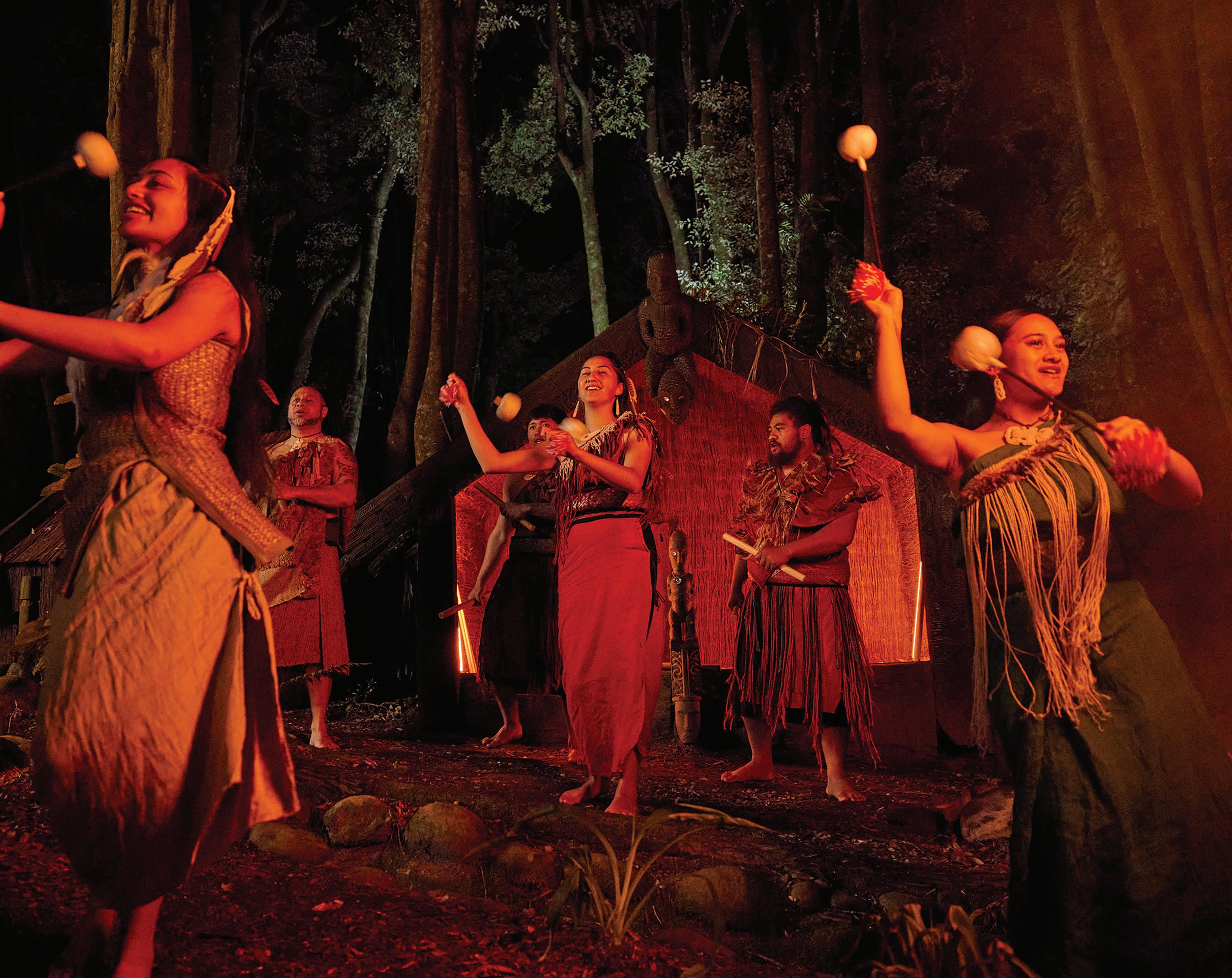
Te Pā Tū is New Zealand’s only pre–European Māori village.
42
From their arrival in the 14th century to today, the Māori have honoured the lands of New Zealand-Aotearoa through kaitiakitanga This tradition of stewardship is all about managing and sustaining New Zealand’s resources while preserving its beauty, wildlife, and waters in accordance with a Māori worldview. From boarding your Air New Zealand flight to Auckland to stepping off your flight home, kaitiakitanga remains an essential part of the New Zealand experience today.
Get Things Brewing in Sulphur City
Everyone stops by Rotorua for its geysers and bubbling mud pits, but it also offers a superb introduction to Māori culture. The hangi feast, cooked in a traditional earth oven, has been part of Māori tradition for centuries and feels like an apt illustration of how critical the land is to the Māori. If you’re fortunate enough to see a Māori dance performance, you’ll see how the land influences other arts as well. To understand the Māori as New Zealand’s custodians, there’s no better place to start than in Rotorua.
Explore a Car-Free Paradise
Hike, bike, or kayak your way along the shores of Abel Tasman National Park (Tōtaranui). The world’s smallest penguin, playful seals (aka “rock sausages”), mighty orcas, and many other creatures populate Abel Tasman and its nearby waterways. The Māori have lived seasonally in the region for almost 700 years, giving its resources time to recover between stays. That legacy of sustainability continues in today’s carbon-neutral, car-free park, found just a short drive from the Marlborough wine region, home to the Sauvignon Blanc served aboard Air New Zealand’s fleet.
Fjords Worth Pining For
Colourful birds thrive in New Zealand’s dramatic Fiordland National Park (Te Rua-o-te-moko a.k.a. Shadowland or Pit of Tattooing), but it’s the marine life that steals the show. Dolphins, seals, and whales are often seen in the waters of Milford Sound, while Doubtful Sound is ideal for serious wildlife lovers, with bottle-nosed dolphins, crested penguins, and southern fur seals on display. A less popular resident is the sandfly, which the Māori say was sent by the gods to prevent humans from getting too comfortable in this region. Te Anau, the nearest town, is just two hours’ drive from either Queenstown or Invercargill, both regular Air New Zealand destinations.
Final Tips for Exploring New Zealand’s Natural Heart
Choose a Māori-guided tour where possible to learn about New Zealand through the eyes, ears, and tastebuds of its custodial culture.
· See playful seal colonies outside Wellington.
· Enjoy some of the world’s best whale watching in Kaikoura.
· Spot rare Hector dolphins in Aotearoa Harbour, just south of Christchurch.
· Spy elusive kiwis at a hatchery or try your luck on Stewart Island if you’re determined to see one in the wild. Catch the ferry from Invercargill, serviced by nonstop Air New Zealand flights from Auckland, Wellington, or Christchurch.
· Marvel at the size of the extinct moa bird at Wellington’s Te Papa Tongarewa museum.
· Feast on fresh, sustainable seafood throughout the country.
· It’s all about the birds and sea life here. There are no native land mammals in New Zealand.

43
Te Pā Tū is the only cultural experience to win the Supreme New Zealand Tourism Award.
Alaska
Where the Wild Things Are
You don’t have to look far to discover Alaskan animals by air, land, and sea.
WORDS JILL ROBINSON

There is an estimated population of around 750,000 caribou across Alaska’s treeless tundra, boreal forests, and mountains.
44
From vast glaciers to coastal forests to tundra, the wide-open spaces of Alaska are home to some of the most beautiful and diverse natural landscapes. The state’s 665,400 sq mi (1,723,378 sq km) are far more populated by animals than by humans, so a trip to Alaska virtually guarantees memorable wildlife sightings. While many visitors embark on cruises to the Last Frontier, land-based trips offer more time among Alaska’s Big Five (bear, caribou, Dall sheep, moose, and wolf), as well as plentiful opportunities to spy marine mammals and even feathered sovereigns of the sky.
Wildlife in the Water
With more coastline than any other state, Alaska’s waters are abundant with denizens of the deep, and it’s not necessary to be on the water to get spectacular views. Known as canaries of the sea for their vocalizations, beluga whales can be spied south of Anchorage along Turnagain Arm. In Resurrection Bay near Seward, look for otters, as well as orcas (killer whales), harbor seals, and Stellar sea lions—who come here for the fish. Get your humpback whale fix in the Inside Passage or the Barren Islands between Homer and Kodiak, where they bubble-net feed in early summer. “Whale soup” is a term for having a wealth of whales, and Prince William Sound more than delivers, with fin, humpback, minke, orca, and sei whales.
Creatures of the Air
Birders flock to Alaska to see nearly 500 species of birds, offering one of the richest birding opportunities in North America. With the spring migration, millions of avian species make their way north to Alaska to revel in the long summer days before their southerly trips for the winter. Glacier Bay National Park has rich bird life, and a land–based trip gives you a closer view of bald eagles, pelagic cormorants, rufous hummingbirds, marbled murrelets, tufted puffins, and more. Thousands of sandhill cranes stop here in migration, with peak numbers in September. Among an estimated 200,000 seabirds that summer in Prince William Sound are marbled murrelets, black–legged kittiwakes, and glaucous-winged gulls. Several birding sites near downtown Anchorage provide year–round opportunities to spy a variety of corvids, raptors, shorebirds, and songbirds.
Animals of the Land
The wild landscapes of Alaska are a welcoming home to black and brown bears, and the safest way to view them is on a guided tour where you can watch them live their lives undisturbed. Prince William Sound is an ideal habitat for both bear species, as well as for moose and mountain goats. Perhaps one of the best-known images of bears in Alaska is of brown bears fishing for salmon at Brooks Falls, where as many as 50 can be seen during spawning season, and visitors get optimal views from a series of platforms. Be sure to look for other mammals, as well, like beaver, caribou, lynx, red fox, river otter, wolf, and wolverine. Spy Dall sheep in the Chugach Mountains near Turnagain Arm, and large land animals like bison, caribou, moose, and wolf.
45

Seasonal Whale Watching Calendar
Depending on when and where you go, there are many opportunities to spot whales in the wild.
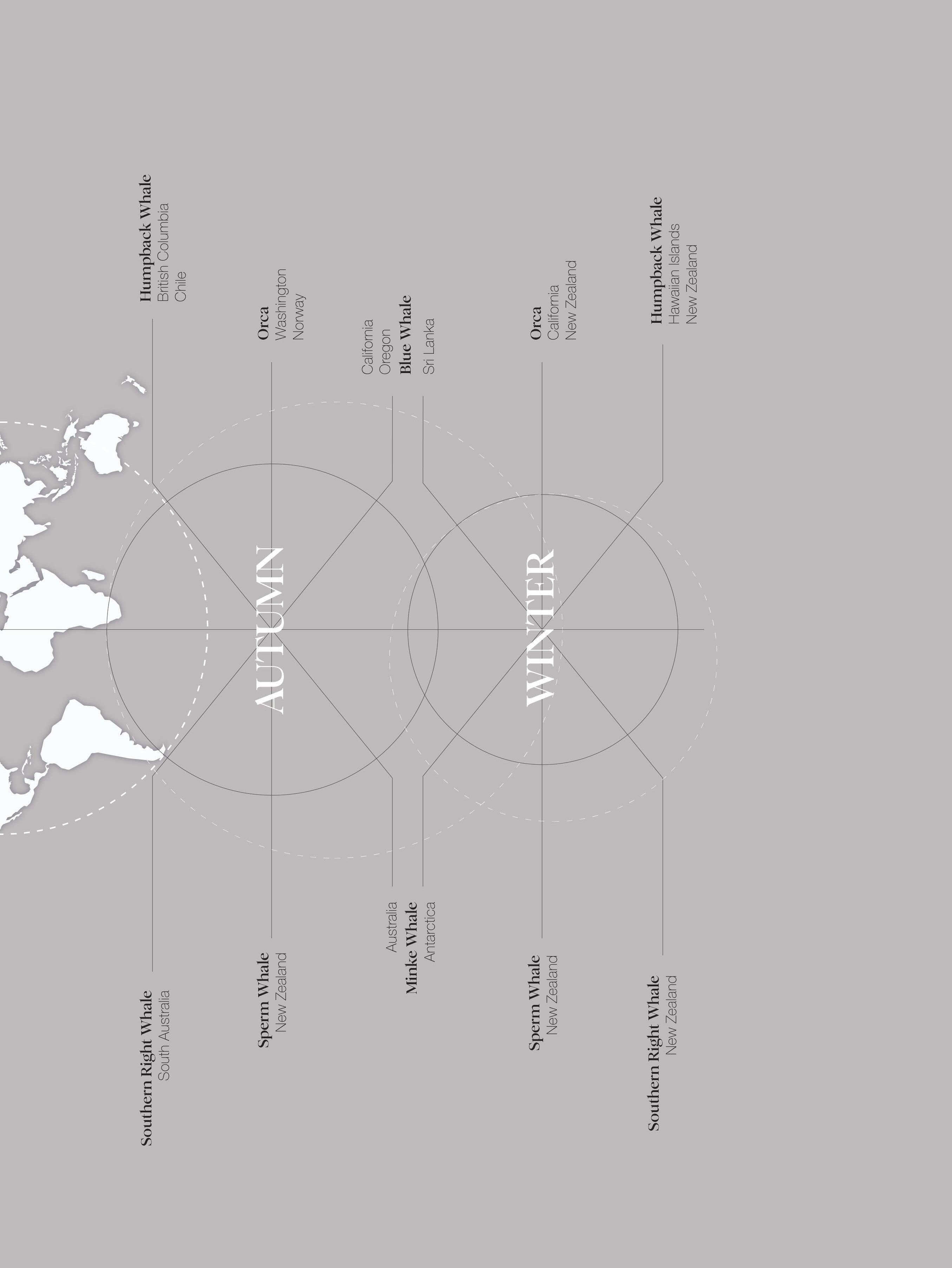
There are few wildlife experiences more majestic than spotting a whale in the wild. Seeing a whale’s dorsal fin first cresting the waters or its fluke slap the waves before escaping into the ocean is the sort of sight to give you goosebumps. If you’re lucky enough to see a whale actually breach, you’ll never forget it—and likely never stop telling your friends and family about it. Just imagine the pictures! But sometimes it’s hard to know when and where to go to spot a whale in the wild to make these sorts of experiences possible. We’re here to help with a seasonal whale watching calendar showcasing some of the most common whale species. This calendar is a starting point to a whale watching journey, as migratory patterns and feeding behaviours are always shifting based on climate change and weather conditions. Sightings on a whale watching excursion are never a guarantee, but these destinations during these times of the year will give you your best chance at seeing some of the beautiful mammals that inhabit our oceans.
Into the Bush: The Long, Careful Work of Mountain Gorilla Tracking
Getting mountain gorillas used to the presence of humans is an intensive process that requires years of training and supervision.
WORDS AREN BERGSTROM

Few wildlife experiences compare to seeing a mountain gorilla in the wild jungles of Uganda. After hiking for several hours through dense forest, you have a single hour to spend with the gorillas, who let you share the space and observe them from a strict 32 ft (10 m) distance. It’s magical but also requires intensive preparation from a team of specialists over several years.
Bwindi Impenetrable National Park in southwestern Uganda is home to around half of the world’s mountain gorilla population. It’s one of the few places in the world where travellers can observe mountain gorilla families in the wild. These families get used to the presence of humans through a rigorous tracking process that is overseen by conservation professions and wildlife authorities.
“Habituation is a process of getting gorillas accustomed to human presence without altering their natural behaviour,” says Nelson Guma, Conservation Area Manager with the Uganda Wildlife Authority, which oversees gorilla tracking in Bwindi. “It all starts with assessing a wild group that is viable for tracking.” These family groups typically have at least six individuals and comprise a silverback (the term for the dominant male, named for their distinctive silver fur), an adult female, some younger adults, and several juveniles and infants. Once a group is identified, trackers put together a specific program for the family.
The first step is searching for signs, which “can include fresh animal trails, feces, and chewed vegetation,” says Nelson. The trackers follow the signs until they reach the nesting sites. At first, the gorillas may not tolerate the trackers.” Silverbacks may
48
Mountain gorillas do not survive in captivity, and you’ll only find them in Rwanda, Uganda and the DRC.

charge trackers as a sign of annoyance, or the entire family may run away. “As the process is repeated with time, the gorillas get to know that humans are not a threat, and they begin to reduce the gap between the observers and themselves.” Trackers continue to observe the families throughout the day and follow them back to their night nests. Equipped with notebooks, GPS tracking, cameras, and walkie talkies, trackers take copious notes each day and communicate with team members to make sure the daily routines of gorilla families are logged.
After about six months when a moderate level of trust has been built between the family and the trackers, “the family can be accessed by visitors through a gorilla habituation experience. Small groups of four visitors maximum are allowed to participate in the experience for a maximum of four hours. Visitors are
briefed to know that they can expect to observe gorillas at a fairly long distance compared to fully habituated groups and expect to be charged by some members of the family. In this case, the gorillas are getting used to slightly larger numbers of people, as the habituation team carries out mock tourism.”
After one and a half to two years, wildlife management carries out an assessment to determine the gorilla family’s comfort level and whether they recommend them for regular gorilla tracking. “It usually takes about two to three years for a group to be confirmed,” Nelson says.
Even after mountain gorilla groups are ready to share the forest with human visitors, challenges remain. As the local human population increases, the need for space and resources increases, leading to development encroaching on the forest.
49
Uganda mountain gorillas live in troops of 5 to 30 individuals.
Mountain gorillas are nomadic, building new nests daily from branches and grasses.
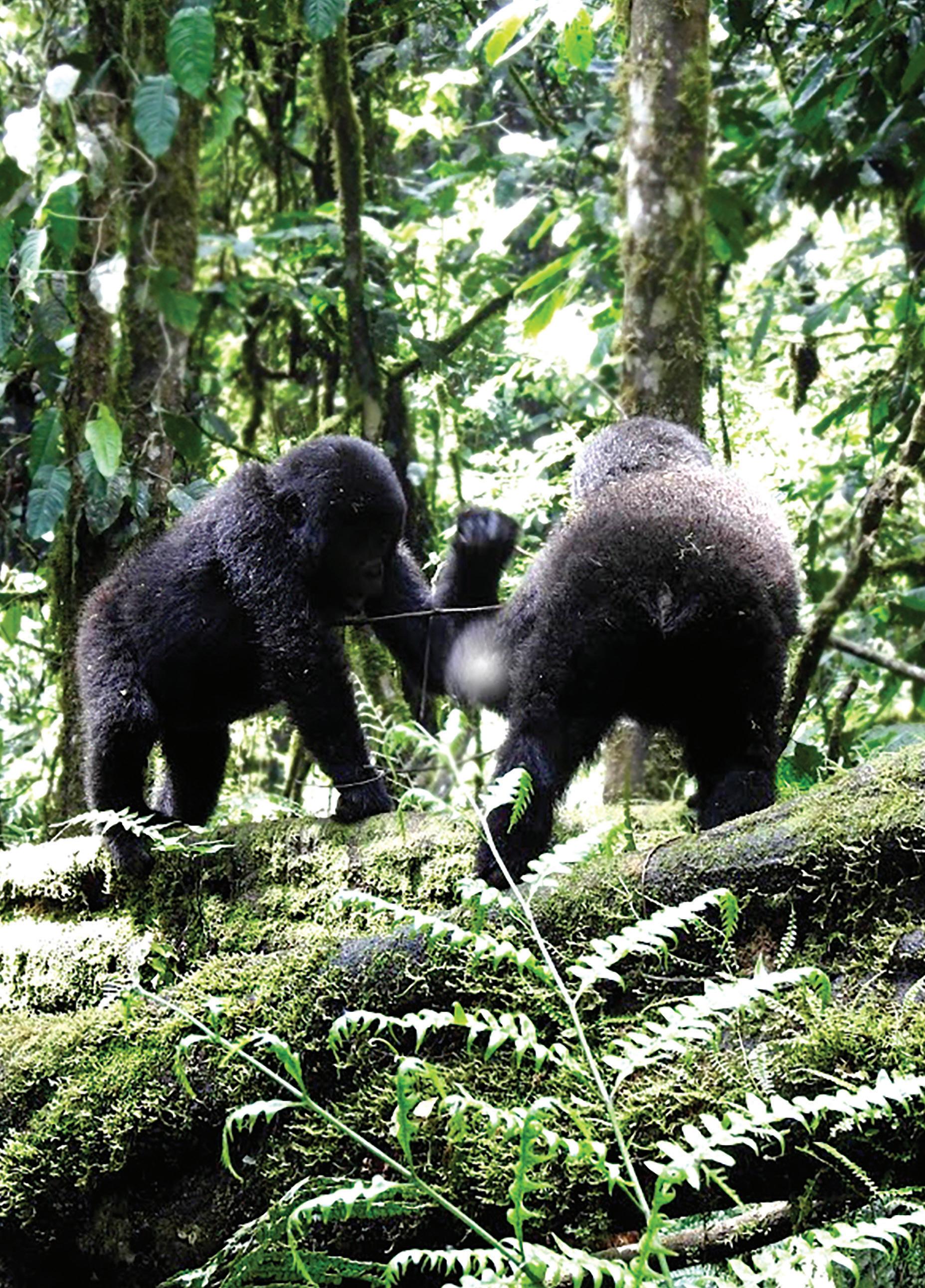
The ever-present spectre of climate change also looms large as it threatens to further shift ecological patterns and force invasive species into gorilla territory.
But wildlife organizations are also committed to tackling these problems head on by improving infrastructure, helping “garner political support for conservation and government intervention,” says Nelson, and establishing strong relationships with the local communities living on the edges of gorilla territory.
If you’re lucky enough to track mountain gorillas in the wild, realize that you’re following the path cleared for you by countless individuals such as Nelson Guma and his team. This profound interaction is made possible by the dedication and expertise of wildlife professionals committed to the preservation of gorillas. Years of hard work go into one special hour with our primate cousins.
50
The Story Bridge spans 2,549 ft (777 m) over the Brisbane River.
Guardians of the Green: The Bishnoi Legacy of Wildlife Conservation & Sustainability
How a small religious community in Rajasthan, India keeps sustainable traditions alive.
WORDS DHRUV RAZDAN
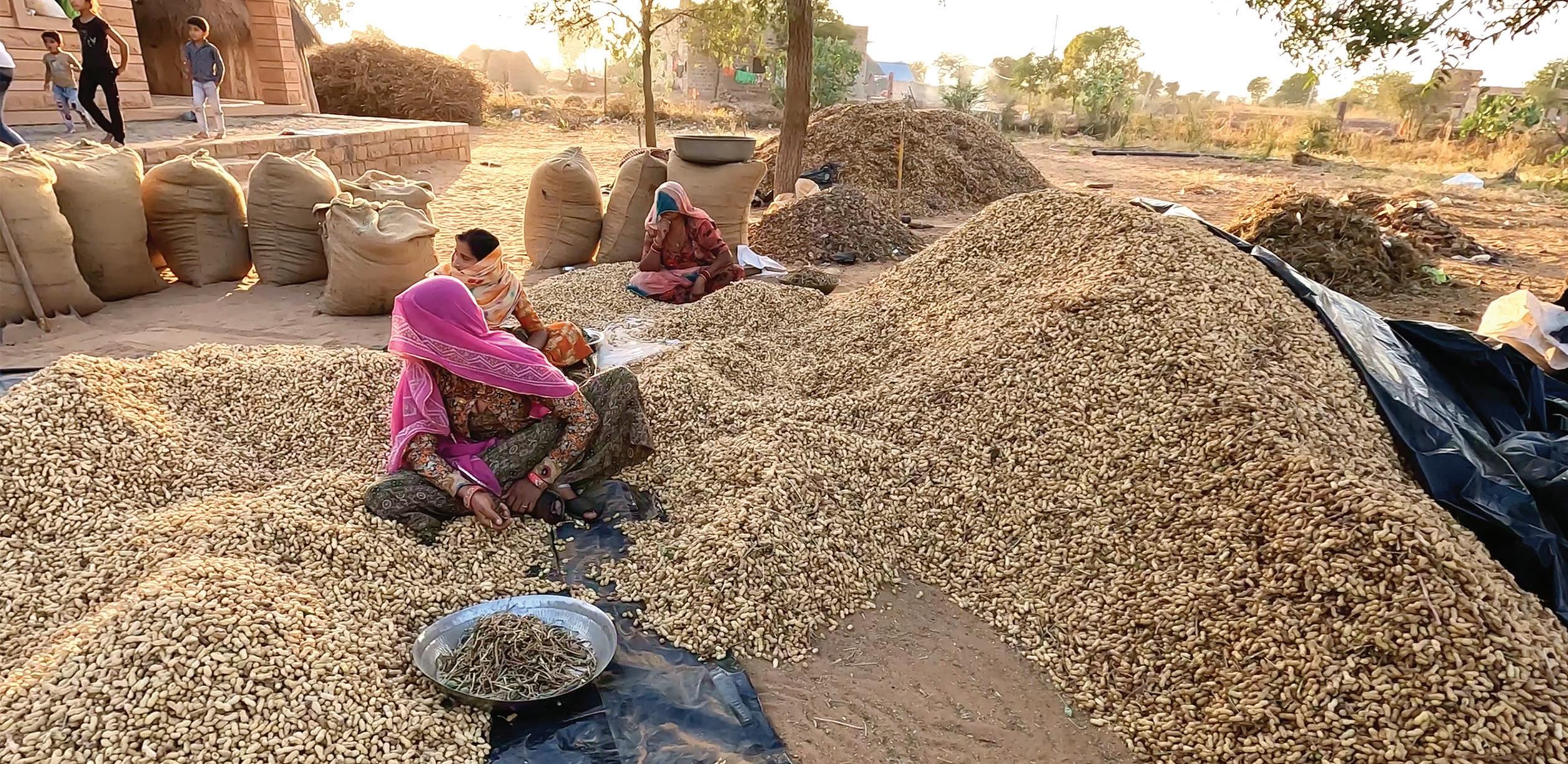
Back in 2021, I planned an explorer’s road trip of Rajasthan with the objective of experiencing the offbeat destinations of the once princely state of India. Rajasthan is known for its palaces, desert, temples, and wildlife, but its real stories lie in its villages.
On a bright, sunny day, I found myself wandering through an arid landscape on a quest to uncover stories of a community committed to extraordinary environmental responsibility. My journey led me to a small village in Osian inhabited by the Bishnoi community. Known as the Guardians of Nature, the Bishnoi live by principles that seem to belong to another era. Despite their adherence to centuries old wisdom, their day-to-day practices are in sync with the modern notions of sustainability and environmental conservation.
The Bishnoi are members of a sect of Hinduism with around 600,000 adherents in northern India. Followers of Guru Jambheshwar, they abide by 29 principles (bish-noi translates to “twenty” and “nine”) that intertwine their lives with the environment. These principles include never cutting green trees, providing shelter to abandoned animals, never consuming meat, and avoiding wearing the colour blue due to the use of indigo in the dye. Their way of life is a testament to sustainable living.
As I ventured into the village near Osian, I was warmly invited to the house of Mr. Amra Ram, a respected leader within the Bishnoi community and the head of the family. He passionately explained the 29 principles that guide their lives, everything from daily routines like bathing and meals to clothing choices.
51
The village comes together for the important annual peanut harvest.

Cows, like all animals, are regarded with deep respect.
Community wells are essential to sustain the community.

A mountain of peanuts lay in front of the house, a testament to the fresh harvest I was lucky enough to witness. Knowing it came from the Bishnoi, I could be confident it was organic and fresh. They explained that this peanut harvest is precious, as it only comes once a year. The family also grows other produce such as wheat, mustard, and cumin. Learning this was particularly fascinating considering the location: Rajasthan boasts some of the most infertile lands in India, including the vast Thar Desert. However, long-term government initiatives and support from the local populace have made these lands more fertile than ever, giving the Bishnoi
people the opportunity to earn a living through crop sales.
Following our conversation, I ventured into a Bishnoi field. Here, I witnessed their self-sufficiency firsthand. Their crops flourished, and the unique building material used for their houses caught my eye. A special blend of clay and cow dung, this plaster keeps their homes cool during the scorching summer and warm during the chilly winters. Sustainability wasn’t limited to their dwellings; I learned about their ingenious rainwater collection system, ensuring a precious resource for both drinking and irrigation.
One principle resonated deeply: a profound respect for nature. The Bishnoi people consider it paramount to protect trees and animals, which is evident in their strict vegetarian diet. In my interactions, they spoke of wildlife with a reverence that was both humbling and enlightening. In a world where sustainability is often discussed theoretically in boardrooms and conferences, the Bishnoi have been living it practically for every day of the past 500 years.
The Bishnoi’s supreme respect for nature is evident in the story of Amrita Devi Bishnoi, who, along with 362 others,
52
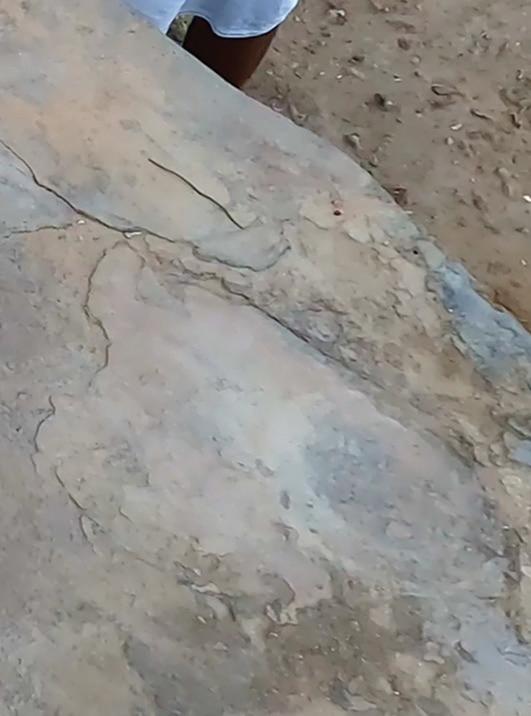

sacrificed her life to protect khejri trees. In the early 18th century, a part of Rajasthan was ruled by the Marwar Kingdom. The king at that time, Maharaja Abhai Singh, ordered his troops to cut khejri trees from the village of Khejarli for his palace. Khejarli happened to be Amrita Devi’s home.
As the troops arrived at the village to begin their collection, Amrita Devi roared and vowed no trees shall be cut from the village as the land belongs to the followers of Bishnoi. She warned the troops that to cut through the tree they would have to cut through her. The general offered the
villagers a bribe to let them cut the trees, but this only insulted the villagers. More people joined Amrita Devi and hugged the trees. The confrontation escalated as Amrita Devi wouldn’t budge. Her famous last words are said to have been: “A chopped head is better than a chopped tree.”
The story of this encounter left me in awe. Here was a community, living simply, that was far more dedicated to conservation than the most passionate advocates of sustainability and green living I had encountered in my urban life. The Bishnoi people are proof that sustainable progress is not about technological advancement,
but about truly living in harmony with nature. The Bishnoi live by and die for the protection of beings that cannot speak for themselves. Their story is a powerful reminder that sometimes the most advanced ideas come from the simplest of lives.
53
Mr. Amra Ram, a respected village leader tells the story of the Bishnoi people.

The Other Corcovado: Costa Rica’s Biodiverse Haven
Remarkable wildlife encounters in Costa Rica’s little-known South Pacific.
WORDS MARCK GUTT

For us non-Portuguese speakers, if Corcovado rings a bell, it’s because of a giant Christ overlooking Rio de Janeiro. Somewhere in Central America, though, the word evokes something different.Corcovado is one of Costa Rica’s 27 national parks, a reserve with limited human intervention that hosts around 2.5% of our planet’s biodiversity and is visited by fewer than 100,000 people per year.
Impenetrable forests, quiet beaches, and trails where coatis are more common than people are just a few of Corcovado’s features. The lushness, however, isn’t for everyone. Exploring the Osa crocodiles, harpy eagles, and the four species of Costa Rican monkeys, but it requires sacrificing urban luxuries, bidding farewell to 5G, and walking on improvised paths.
Personally, it is tapirs that convince me to venture into Corcovado. Costa Rica is one of the few places where you can spot a Baird’s tapir in the wild and according to statistics, this reserve is a good place to try your luck. With hopes of sighting Central America’s largest land mammal, I leave the remote coastal village of Carate and delve into Corcovado.
A pristine beach leads me to Leona, the southernmost sector of the park. Gradually, the sunlight and the signal bars disappear, leaving behind hundreds of hermit crabs and almond trees full of scarlet macaws. “Why Leona?” I ask the guide, implying that lions reside on the other side of the Atlantic (leona is Spanish for lioness). “ Jaguars, ” he says. Although we don’t spot them easily, they’re keeping a close eye on us.
Tucked in the jungle, La Leona Ecolodge awaits with tents too comfortable to be called camping yet too rudimentary for glamping. Like every room, mine is illuminated solely by candlelight. Outside, joined by a choir of unrecognizable animal calls, the sky reveals constellations that can no longer compete with urban glow.
The next morning we rise with the sun to make the most of daylight. Álvaro, our local guide, is ready to hike the trail separating Leona from Sirena. We stroll without hurry, stopping more often than not. The reasons? Toucans, hummingbird nests, and Golfodulcean poison frogs endemic to the Osa Peninsula. We come across less than 20 people along the way, but when it comes to flora and fauna, we lose count.
The hike back is more intense. The tropical heat has taken its toll, and a shower sounds heavenly. We pause when howler monkeys momentarily make me think we’re surrounded by big cats. Soon after, we continue and reach the hotel with time to rest before the night walk. After all, tapirs are often active at night.
Equipped with rubber boots and flashlights we set out to explore the surroundings. We agree to spend about an hour outside. How naive! Three hours and several critters later, we’re wandering happily and aimlessly. It rains and stops raining in a loop. Most people wouldn’t want to stumble upon a grumpy-looking fer-de-lance, but when we spot the viper from a distance, we feel like we’ve hit the jackpot.
Here, nature dictates everything. The trails, though always the same, are never identical. If it’s not the time of day or the number of clouds, it’s the animals encountered along the way that make Corcovado unpredictable. Every scene here is worthy of David Attenborough narration.
Did I see any tapirs? Not one. Statistically, the trip might be considered a failure, but for me, it was quite the opposite. Corcovado left me with postcard views that rival paradise, trails shared with anteaters, and scorpions that look ghostly under UV light. Not bad for a consolation prize.
55
Keeping it Green in the Wonderful Western Cape
South Africa’s haven for sustainable travel experiences.
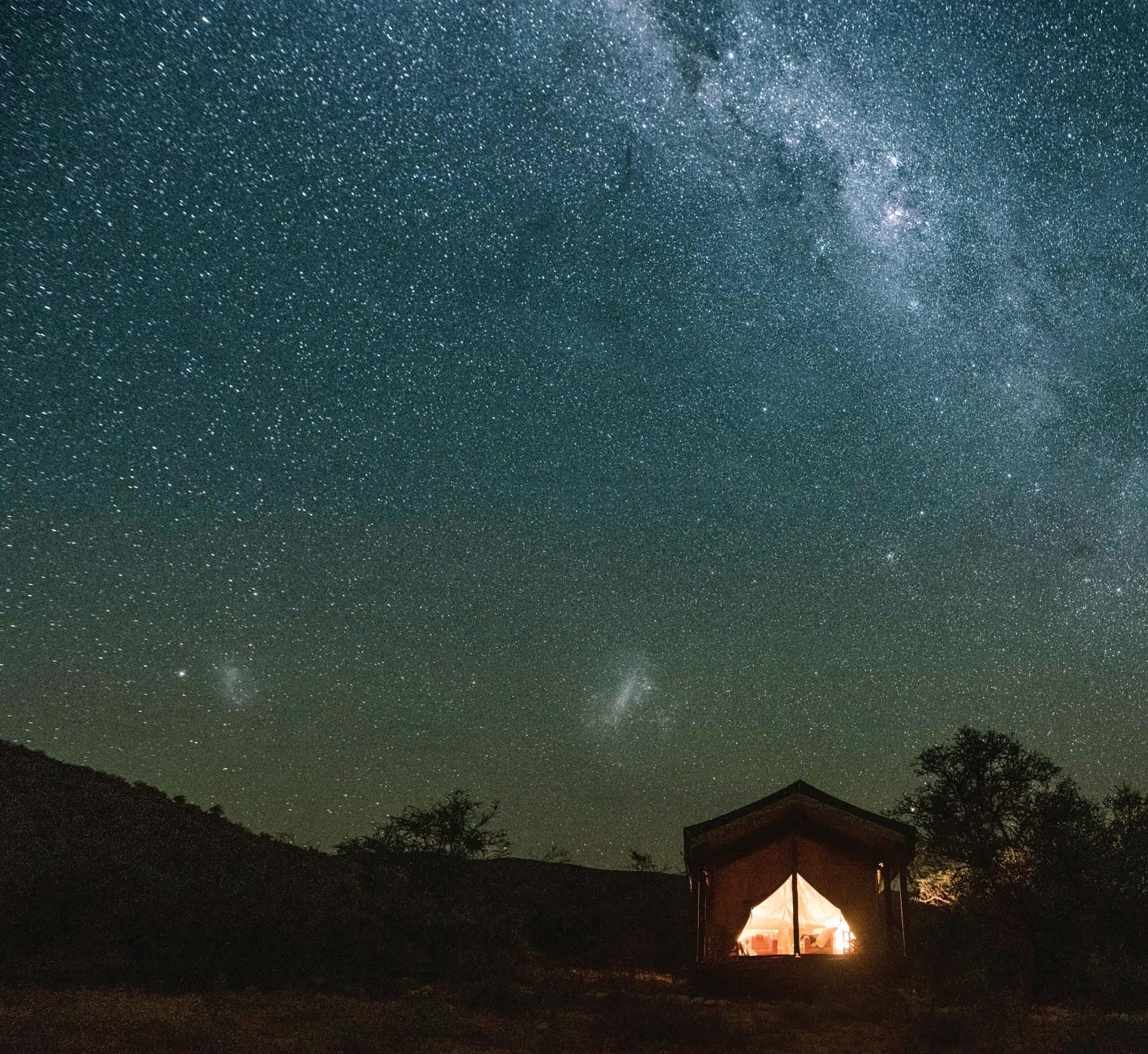
South Africa’s Western Cape seduces travellers again and again with its natural beauty, dedication to sustainability, and incredible range of flora, bird, and ocean life. With one of the world’s most famous mountains at its centre, and two oceans on its doorstep, Cape Town’s geography, culture, and devotion to sustainability make it one of the most desirable cities to live not just in Africa, but worldwide.
A Floral Kingdom in Africa’s Greenest City
With a stunning location and year-round idyllic weather, the outdoors is a vital part of Cape Town’s lifestyle. The city draws a steady stream of repeat visitors, sometimes for weeks or even months as they make friends with locals and explore Cape Town beyond its biggest attractions. Taking a “sustainability starts with its people” approach, the city is actively curbing urban sprawl, with new nature reserves popping up in what is already one of the world’s best cities for hikers.
Still, if you can tear yourself away from the awesome views, you’ll have time to admire South Africa’s vast range of plant life and wildflowers. Kirstenbosch National Botanical Garden brings the
country’s flora to the suburbs, with eye-popping art installations to remind you that nature and culture go hand in hand in. With a few more days up your sleeve, you can drive up the Garden Route, where many of the Cape’s plant species grow wild.
Feathered, Fierce & Fabulous
A colony of African penguins have called Boulder’s Beach home since 1982. They’re not the only colony on the Cape, but they’re certainly the most famous, with their own dedicated viewing boardwalk, ensuring great photos and happy, healthy penguins. You can even swim at designated spots nearby, carefully chosen to avoid disturbing the birds.
Not
all South
Africa’s birds are so proper and petite as its penguins. The ostriches of Oudtshoorn are not afraid to show off, either on a farm where you can feed them and learn about the enormous industry they support, or in the wild, ideally on safari. If you do encounter a wild ostrich on the road, give these divas their space. They’re fast and can do serious damage to your rental car if they feel threatened.
56
WORDS CHRISTIAN BAINES
It’s hard to top the starry nights of the Western Cape.



There are so many bird species here that South Africa has created the continent’s first dedicated birding route project. Across a range of routes (it’s a big country), the sightings on offer are too numerous to list, but the route’s designers recorded 220 different species in the Western parts of South Africa in just one day.
Going Wild Where Oceans Meet
The wildlife encounters get more extreme offshore. Steel your nerves and take the plunge for a cage dive to experience a variety of shark species including white sharks, bronze whaler sharks, seven-gill sharks, and rays that populate South Africa’s warm waters. If you’d rather stay high, dry, and away from the ocean’s most famous predator, whale watching safaris run from June to December, inviting you to spot these playful giants as they round the Cape. Seal colonies dot the coast as well, so you’re never far away from an exciting marine life adventure on the Western Cape.
Oudtshoorn is considered the Ostrich Capital of the World.
 Knysna turacos are iconic companions in the Garden Route.
Bosjes boasts award-winning design in the Breedekloof Valley.
Knysna turacos are iconic companions in the Garden Route.
Bosjes boasts award-winning design in the Breedekloof Valley.
A Group Safari in Kenya & Tanzania
Group safaris are exhilarating vacations but require some careful planning to pull off.

Group travel comes in all forms and the planning process is never the same for any two groups. To highlight the unique group planning process, we connected with Sue Flemming, Adventure Travel Specialist at Jane’s Worldwide Travel, to learn about her experience as a group leader with Goway Groups Only.
What inspired you to first get involved in group travel?
I have many clients wanting to visit destinations that were a little more adventurous, but still wanted to feel safe. I floated the idea of an African safari to a group of friends and we sold out quickly. This first trip gave me the confidence to pursue group travel as a specialty area.
How did you come up with the idea for your trip?
During COVID, I started thinking about bucket list travel. I did a webinar on sky safaris with Goway [sky safaris are safaris with a private plane to connect between game parks and reserves]. It was combining Kenya and Tanzania and seemed perfect, as we would have our own plane and no waiting in airport lounges. I chose migration season as most people are familiar with the iconic National Geographic photos of wildebeest crossing the river.
How did you get others to join?
I started by contacting a local museum and library to see if they would be interested in allowing me to host general presentations on adventure travel. This helped me build up my clientele until I found there was enough interest to target a specific audience for African safaris. I then contacted Goway and we put together
a great presentation. Moira Smith, VP Africa & Asia, was kind enough to present at one of the talks, which was extremely well attended. After this, I developed a list of people interested in this type of travel and promoted and filled specific groups.
What challenges did you encounter during the planning process?
Honestly, there weren’t many challenges, but I did have a few group members drop out due to serious illness and Goway Groups Only allowed me the flexibility to fill these spots. Also, being able to lock in the rates so early (almost two years in advance) was extremely beneficial in keeping within budget. [Goway Groups Only recommends you start planning your group at least 18 months in advance to secure the space and lock in best rates.]
What are some of the group highlights?
The day we arrived at the Mara River the wildebeest immediately started to cross. It was as if they knew we were there, and it was time to put on a show! There were many tears of joy that day (including from me).
What advice would you give to other group leaders?
Absolutely rely on the experts in your chosen destination to lead you through the full process from start to finish. When choosing a destination such as Kenya or Tanzania, it is imperative to have someone on the ground with local knowledge and the ability to calmly and quickly solve any issues that arise.
58 GROUP TRAVEL PLANNING

You Can be a Group Leader!
Are you a foodie, a golfer, a lover of adventure, part of a large family, part of a special interest group, or just enjoy travelling with friends? If so, you can be a group leader! Whatever your reason for travelling or who you want to travel with, Goway Groups Only is ready to help you plan a tailor-made group trip as unique as you and your companions.
At Goway Groups Only, we’re the experts in planning custom group vacations for any group of 10 or more travellers. No matter your interests or travel needs, we have the expertise, connections, and travel experience to plan a trip that’s right for your group. Rely on the real group experts to tailor a group vacation full of unique inclusions and unforgettable experiences.
We make booking groups easy!
• One of the Largest Dedicated Groups Teams in North America
• Tailor-Made Group Trips to 115 Countries Worldwide
• 54 Years in Business
• Group Leaders Can Qualify for FREE Trips

TRAVEL LIKE A GLOBETROTTER
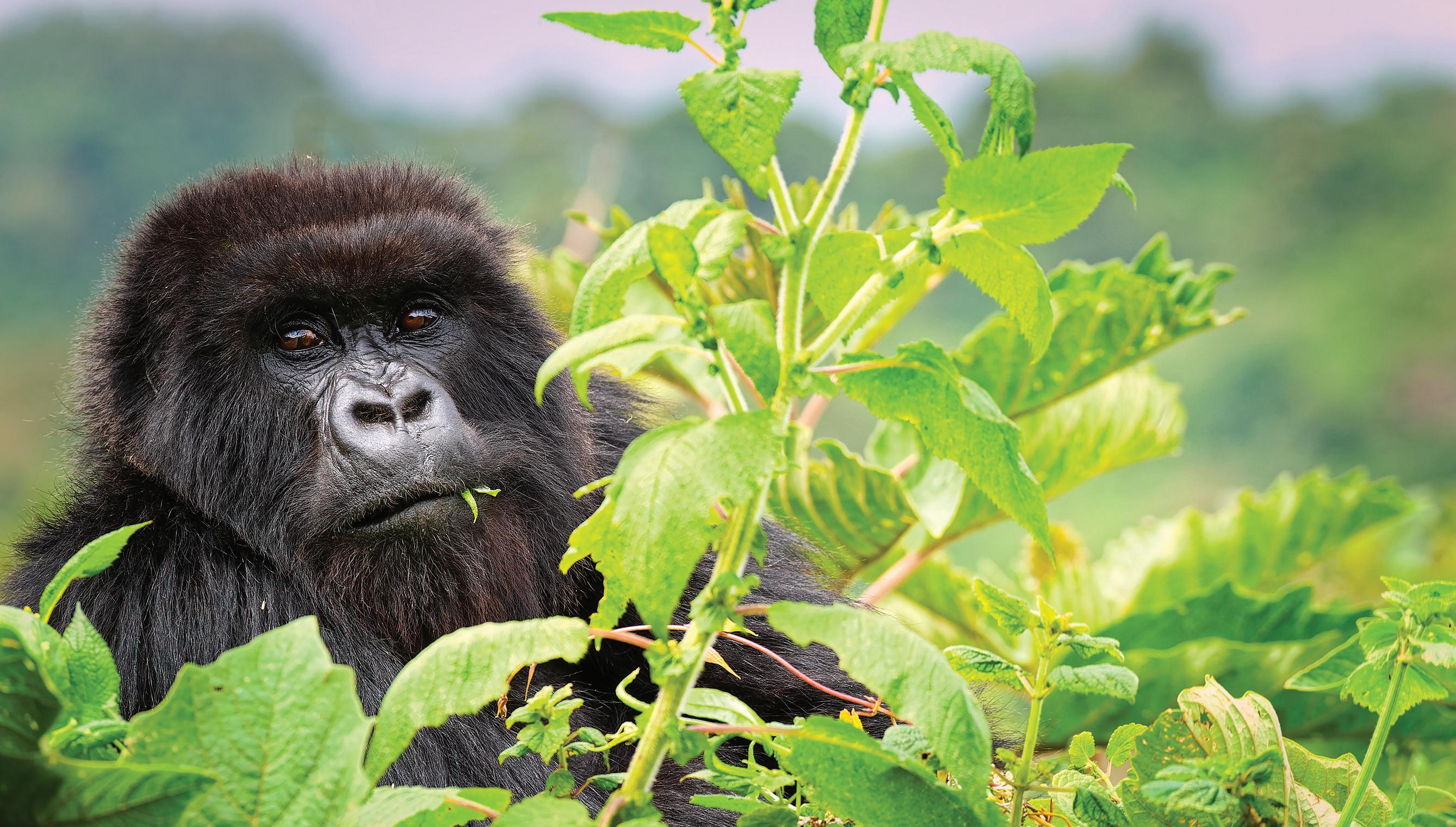

The Timeless Appeal of Going on Safari
Safaris are as diverse as the wildlife they showcase and make for lasting memories.
WORDS CAROLYN WEPPLER
There are few travel experiences quite like a safari, which allows you to take a break from everyday busyness. You’re up before dawn each day and the world surrounding you is quiet. You spend your evenings under the stars with no light pollution, a campfire, and stories as your entertainment. Breakfast in the bush or a sundowner next to a gorge are the sorts of special touches that elevate the experience.
There’s also no such thing as a cookie cutter wildlife experience on safari. My most memorable experience was gorilla trekking in Volcanoes National Park, Rwanda. When gorilla trekking, you have a single hour to watch your gorilla group and see them interact. We were watching a toddler-sized gorilla rambunctiously playing with a grade schooler-sized gorilla and suddenly, the mother gorilla gently pushed me aside to put a stop to the shenanigans. It was exactly what I would have done with my own children, and I’ll cherish the memory forever.
Another unique experience was in the Masai Mara, Kenya while staying at Cottar’s 1920s Safari Camp. I went running with a
young man that worked there: me in my running shoes and my guide in his sandals recycled from tires. We passed 1.86 mi (3 km) through the bush, a safari vehicle following closely behind, spotting zebra and impala in the tall grass.
Even my most recent safari at Old Drift Lodge in Victoria Falls, Zimbabwe had exhilarating moments. At dusk, we were heading back to the lodge when we encountered a pride of lions stalking young water buffalo. Suddenly, a herd of elephants arrived on the scene, and it was complete mayhem with animals running everywhere and three large elephants mere feet from our vehicle.
Safaris create memories that stick with you. For the most intimate wildlife experiences, I recommend a private game lodge or tented camp experience, where the vehicles are small and take no more than five to seven guests. There are also many countries that offer more than wildlife viewing such as South Africa, where you can enjoy world-class food and wine, or Tanzania, where you can easily add on a fabulous beach stay in Zanzibar. But no matter how you go on safari, you’ll never forget it.
60

• Stay Longer, Explore More
• Join Small Groups for Close Connections
• Enjoy Elevated Travel Experiences
• Receive Premium Service Guided by
Introducing Odysseys by Goway Unforgettable Small Group Journeys, Guided by Goway.
Tanzania,
India, East Africa, Japan Cherry
Globetrotters There are 12 Odysseys currently available: Write your own epic travel story. Embark on an Odyssey by Goway today!
Kenya, Ghana, Egypt, Saudi Arabia,
Blossom, Japan Autumn, Peru, Italy, New Zealand goway.com
The Goway Bird
Goway is the only travel company with an official bird—sort of.
In the early 1970s, Bruce Hodge visited South Africa to meet his eventual wife Claire’s family for the first time. When he mentioned the name of his new travel company, Goway, her family was excited to show him a native bird called the grey lourie, common in the Afrotropics. The bird is more commonly known as the go-away-bird because of its distinct call—it sounds like the bird cries “go away!” You could say hearing the bird’s call for the first time was like a sign from the heavens, meaning the name Goway was the right one for his company. Bruce feels certain that the bird is actually calling “Goway!” Be sure to listen for it when visiting South Africa.

62 THE ARCHIVE
On a tailor-made Goway vacation, you do the dreaming, we do the planning.
Our Story
From its inception, Goway has been fuelled by a passion for travel. In 1970, Bruce Hodge moved from Australia to Canada and founded Goway out of his apartment in Toronto. Over 50 years later, Goway is one of North America’s leading travel companies and the the foremost provider of travel experiences to Australia, New Zealand, and the South Pacific.
Goway offers tailor-made trips to over 115 countries worldwide. It’s a family-owned company still owned and operated by Bruce Hodge, which employees over 600 team members around the world. Its headquarters is in Toronto and it has offices in Vancouver, Los Angeles, Sydney, and Manila. Goway plans tailor-made travel experiences for world travellers, while also providing wholesale travel services to professional travel advisors. As well, Goway has dedicated groups, air, and corporate divisions.
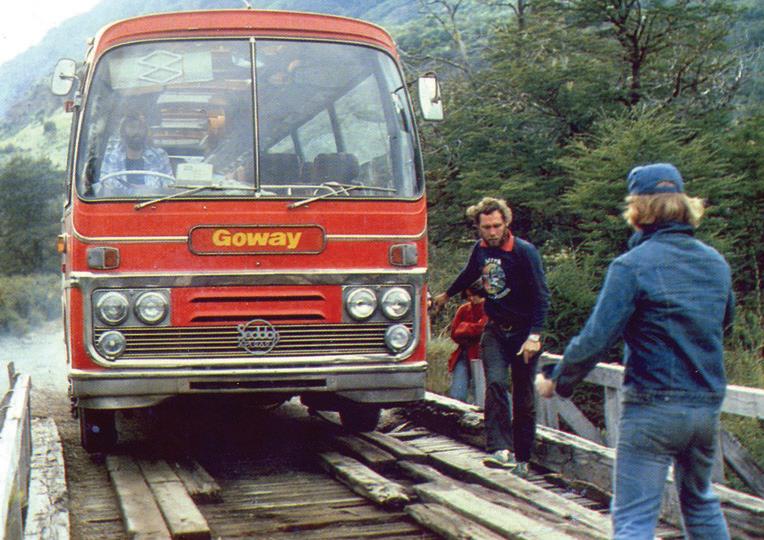
Visit Goway.com to book today!
Tailor-Made
Every trip planned with Goway is tailored to your exact needs and interests.
Elevated
Goway offers exclusive travel products with up to 5-star accommodation and a focus on privateguided touring.
Expert
Our Destination Specialists are authentic experts, having lived, worked, or travelled extensively through the destinations we sell.
Global
We offer tailor-made travel experiences to over 117 countries on all seven continents. With Goway, you can explore the whole world your way.

& SOUTH PACIFIC AFRICA & MIDDLE EAST ASIA UK & EUROPE CENTRAL & SOUTH AMERICA POLAR VOYAGES ® US & CANADA DOWNUNDER ABOUT GOWAY
In the 1970s, Goway specialized in overland tours, which often featured exciting bridge crossings, as pictured here.


$14.99 CAD / $10.99 US




























































 You can find cheetahs hunting in open grasslands and savannahs on safaris across Africa.
You can find cheetahs hunting in open grasslands and savannahs on safaris across Africa.































 Knysna turacos are iconic companions in the Garden Route.
Bosjes boasts award-winning design in the Breedekloof Valley.
Knysna turacos are iconic companions in the Garden Route.
Bosjes boasts award-winning design in the Breedekloof Valley.









